new posts in all blogs
Viewing: Blog Posts Tagged with: how to, Most Recent at Top [Help]
Results 51 - 75 of 347
How to use this Page
You are viewing the most recent posts tagged with the words: how to in the JacketFlap blog reader. What is a tag? Think of a tag as a keyword or category label. Tags can both help you find posts on JacketFlap.com as well as provide an easy way for you to "remember" and classify posts for later recall. Try adding a tag yourself by clicking "Add a tag" below a post's header. Scroll down through the list of Recent Posts in the left column and click on a post title that sounds interesting. You can view all posts from a specific blog by clicking the Blog name in the right column, or you can click a 'More Posts from this Blog' link in any individual post.
By: Virginia S Grenier,
on 5/18/2014
Blog:
Utah Children's Writers
(
Login to Add to MyJacketFlap)
JacketFlap tags:
tips for crafting a picture book,
celebrating great authors,
Utah writing community,
podcast,
Author Interview,
stories for children,
blog talk radio,
How To,
books for young readers,
live chat,
Add a tag

The Stories for Children show is on Mondays and hosted by Mom's Choice and Award-winning Author Virginia S Grenier, who is joined weekly by guest authors to talk about writing for children and/or their favorite children's/YA books. Grenier, with her guests, hope to not only share their love of the written word, but also what makes a good book for young readers and much more.
This week on Monday May 19, 2014 at 3pm Pacific - 4pm Mountain - 5pm Central - 6pm Eastern, Grenier will be joined by two members of the Utah Children's Writers blog team.
Our guests are: Scott Rhoades has enjoyed writing since he was about five years old, when he used to make his own books by tracing pictures and making up stories to go with them. He especially enjoys writing stories set in the Middle Ages. He was a technical writer for Novell, Inc. from 1992 to 2007, after starting his career at Atari in 1988. He currently runs his own company,
Write Field Documentation Services, LLC. He is also on the Board of Directors of The Tiferet Center, a center for Jewish education, ritual, and community service based in Vermont. Learn more at
http://www.scottrhoades.com/index.html Julie Daines spent eighteen months in London where she studied and fell in love with English Literature, Sticky Toffee Pudding, and the fellow who ran the kebab store around the corner. After editing for other authors, she decided to take up writing again--this time in the young adult genre. Learn more at
http://www.juliedaines.com/Writers are invited to call-in during the show at (714) 242-5259 or join us in our chatroom located on the show page (
http://www.blogtalkradio.com/worldofinknetwork/2014/05/19/utah-childrens-writers--the-stories-for-children-show)!
Learn more about our shows and network at our website
http://worldofinknetwork.com Find great books and articles on
our blog or follow us on our
Facebook Fanpage You can also catch the show through Facebook, Twitter, itunes and many more!
Listen in Monday May 19th at 4pm Mountain at
http://www.blogtalkradio.com/worldofinknetwork/2014/05/19/utah-childrens-writers--the-stories-for-children-show

By: Kathy Temean,
on 5/13/2014
Blog:
Writing and Illustrating
(
Login to Add to MyJacketFlap)
JacketFlap tags:
Author,
inspiration,
Advice,
Art Exhibit,
How to,
Researching Agents,
Guest Blog Post,
Erika Wassall,
Jersey Farm Scribe,
Add a tag
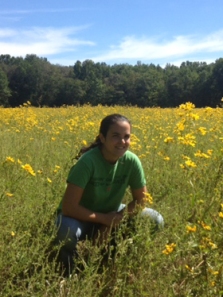
Jersey Farm Scribe here on…
Researching Agents
A completed, polished and ready to be submitted manuscript is a beautiful thing. Now it just has to find a home! But not just ANY home. It has to be just right.
You want the world to see this manuscript! See it’s creativity, it’s uniqueness and the joy it will bring others!
You’ve written your query letter and you’re ready to track your submissions.
But who should you submit to?
If you’re like me, the first thing you think to yourself is…
ANYONE AND EVERYONE!!!!
Then I have sit back… rein in my crazy… and remind myself… absolutely nothing is for everyone.
Plus, agents want to know that I’m submitting to them for a reason specific to my manuscript and not feel like I’m just going down a list sending to everyone who popped up when I Googled “Picture Book Agent”.
And wouldn’t you?
Some agents receive 100s of queries a DAY! That’s a LOT to shift through. It’s important that they immediately know that you are submitting to them because there is something special about THEM that makes the manuscript a good fit.
Okay, okay. So I’ll only submit to agents who are a good fit. How do I find that out??
Research!! Research!! And more research!!
Newsletters like Publishers Lunch and sites like Publishers Weekly contain valuable information about deals being made and what’s going on in the industry. This can keep you in the loop about what specific agencies are looking for, or where they think the industry is trending.
Websites like Writer’s Digest have all kinds of agent lists to give you a good starting point of who to look into.
Social media like Twitter or Facebook are excellent ways to learn a bit about the agent personally. You can learn a lot from reading through their posts. You may even find them talking about their MSWL (manuscript wish list)!!
Blogs like this one! Kathy frequently has wonderful posts about what an agent or publisher is looking for. You can also check out blogs like Guide to Literary Agent, and Literary Rambles.
GOOGLE THEM! (Did you know Merriam-Webster’s Dictionary officially listed “Google” as a verb in 2006? Crazy!!)
Before submitting to ANY one, I do a THOROUGH Google stalk… I mean search. I read and re-read every interview I can find with them it. I look at what conferences they attend and what organizations they are a part of. I look up who their past and current clients are and read interviews of them.
And it’s worth it. Being able to say in my query letter that I was drawn to their definition of literary development in their 2007 interview with such-and-such is a great way to show that I’ve done my research!
Which leads me to my last…. And possibly most important point:
BE HONEST! Most of this is obvious. Don’t say you attended a conference they were at if you didn’t, don’t say you were referred to them by someone if you weren’t.
But it’s more than that.
You don’t want to portray yourself as someone you’re not. Don’t say you align with their thoughts on where MG novels were trending towards if you really don’t.
Oh why not? What’s the harm of buttering them up a bit? It doesn’t REALLY matter.
But it does. In this relationship, trust and honestly MATTER.
While there is obviously no need to tell them you do NOT agree with a comment they made, or hated the last book deal they signed, it can be detrimental to the future relationship to say anything that is not an accurate representation of who you are, as both a writer a professional and a person.
The relationship with your future agent will be a give and take that will rely on trust and mutual respect. As innocent as it may seem, you do not want this connection to start off based on a bait and switch tactic.
When you DO land an agent, it will become an important relationship in your life.
Like other important relationships, not everyone is the perfect match and there is some vetting out that is done on both sides before coming together.
You and your agent will join forces and present your manuscript — your blood, sweat and tears, your creation — out into the world. You don’t want that to be a person you just picked off of a list!
It’s worth it, to do the footwork, see who’s out there, and truly find the place your work will be happiest to call home.
______________________________________________________________
Erika Wassall is a writer, a farmer and a liver of life. She is a member of SCBWI and a proud Mad Scientist, bringing science experiments right into children’s classrooms, and hearts. She has a small farm in New Jersey with sheep, chickens, pigs and vegetables. Check out her new website at www.TheJerseyFarmScribe.com where as a first generation farmer, she often takes the long way, learning the tricks of the trade on The Farm. On her website is also The Shop page with tips and a free Q/A from her husband’s mechanic shop, and The Writer page where she shares stories, experiences and characters from the heart. Follow her on Twitter at @NJFarmScribe. She’d love to hear from you!
Thank you Erika for another great post.
Talk tomorrow,
Kathy
Filed under:
Advice,
Art Exhibit,
Author,
How to,
inspiration Tagged:
Erika Wassall,
Guest Blog Post,
Jersey Farm Scribe,
Researching Agents 


By:
[email protected],
on 5/12/2014
Blog:
Perpetually Adolescent
(
Login to Add to MyJacketFlap)
JacketFlap tags:
free books,
Books,
Book News,
COMPETITION,
Twitter,
game,
how to,
win books,
blankety books,
Add a tag

Play Blankety Books and WIN Books!
5pm every Friday on Twitter
How do you play?
We will post on twitter a book title and author with all the letters missing.
eg
_ _ _ _ _ _ / _ _ _ _ _ by _ _ _ _ _ _ / _ _ _ _
Guess a letter by tweeting at us using the #blanketybooks hashtag
eg
“ @boomerangbooks I guess the letter A #blanketybooks ”
We will slowly reveal the book title and author as more letters are guessed (you can guess as many times as you like but only one letter per tweet)
eg
_ _ _ _ A _ / _ _ _ _ _ by _ A _ _ A _ / _ _ _ _ #blanketybooks
_ _ _ _ A _ / _ _ _ _ _ by H A _ _ A H / _ _ _ _ #blanketybooks
B _ _ _ A _ / _ _ _ _ _ by H A _ _ A H / _ _ _ _ #blanketybooks
B _ _ I A _ / _ I _ _ _ by H A _ _ A H / _ _ _ _ #blanketybooks
First correct answer wins the book!
eg BURIAL RITES by HANNAH KENT #blanketybooks
We will contact the winner to post out the prize!
(Australian residents only)

By:
Robin Brande,
on 5/11/2014
Blog:
Robin Brande
(
Login to Add to MyJacketFlap)
JacketFlap tags:
Writing Advice,
Courage,
Adventure,
Writing Life,
Writing,
Inspiration,
Novels,
Getting Things Done,
Novel Writing,
How To Write a Novel,
How To,
Bravery,
Overcoming Fear,
Advice for Writers,
Outdoor Adventure,
Sports Psychology,
Ironman,
Marathon Training,
BB4G,
Adventure Training,
Adventure Travel Preparation,
Climbing Mount Rainier,
Dana Davis,
Ironman Training,
Ironman Triathlon,
Mount Rainier,
Sports Training,
Summit Hut,
Summit Hut Tucson,
Training for Adventure,
Triathlon Training,
Trip Preparation,
Add a tag
Here are the categories I’m dealing with lately: planning a new backpacking adventure. Planning a new book series. Planning another new series in a whole new genre. Which right now equals about 15 new books. I’m not even kidding.
And this morning it was starting to feel a little . . . daunting. As in, Can’t do any of them, just have to sit here and think about what I want to do.
That kind of stupor that could easily go on for days.
But I’m going to approach it a different way this time. Because recently I heard a great talk from outdoor adventurer (and mother and wife and owner of my favorite outdoor store Summit Hut) Dana Davis.
Dana has hiked up Mount Rainier. That right there qualifies her as badass. But she’s accomplished many other physical feats, and is currently training for her first Ironman triathlon, even though as she tells it she has bad knees, bad ankles, can’t run, isn’t so hot at either biking or swimming (I can’t remember which)–clearly not ideal when you’re going to be doing all three for miles and miles in one day.
But somehow that sounds fun to Dana.
And that fun is infectious. While it’s possible that some of the people in the crowd the other night might have thought to themselves, “Dang! I’m going to Ironman it, too!” I have the feeling they reacted the same way I did, which was to take Dana’s lessons about training for something hard and think about how we might apply them to some of the upcoming challenges in our own lives.
I think my favorite piece of her advice was this: Embrace the suck. Recognize that somewhere along the way you’re going to have to deal with a certain amount of discomfort, pain, and unhappiness. But if you recognize that ahead of time, really reconcile yourself to it, then when it shows up you can calmly tell yourself, “Yep, here it is. I knew it was coming. Here’s the suck. Let’s keep going.”
What’s “the suck” for me? There are times in every single backpacking trip when it’s as if I turn to myself and ask, “Did you really think this was fun? Are you really doing this on purpose?” Because mountains are high, trails are long, lightning storms scare the crap out of me, mosquitos bite, dogs roll in human feces (don’t get me started on people not properly disposing of their turds), and things just plain go wrong. That is the nature of outdoor adventures. Of any adventure, really.
I see it with my book adventures, too. When I set out to write something new, I know the time will come when my hands will feel like claws from typing for so many hours at a time, my brain will feel completely exhausted and empty, and yet the drill sergeant in me will try to force me to keep going even though all I really want to do is take the day off and watch Pixar movies. There’s a reason why The Incredibles exists. It is there to restore the worn-out brains of adults all over the world.
In a few days I’ll be posting Dana’s full list for psyching yourself up and preparing for something big, but for now I just wanted to whet your appetite for the whole thing.
Until then, you might want to reread a few earlier posts (that’s right, to psyche yourself up for the next big post. See how it works?):
How To Know When It’s Time To Make a Change In Your Life
Becoming the Possible You
The 100 Things You Keep Meaning To Do
Deciding To Worry About That Tomorrow
Stay tuned!

By:
Robin Brande,
on 5/7/2014
Blog:
Robin Brande
(
Login to Add to MyJacketFlap)
JacketFlap tags:
Quantum Physics,
TED talks,
Mathemagic,
Parallelogram Series,
Videos That Make Us Happy,
Arthur Benjamin,
Fun with Math,
Math Fun,
Writing Life,
Writing,
Inspiration,
Learning,
Mathematics,
How To,
Add a tag
Math is on my mind lately as I wrap up the Parallelogram series. (Yes, Dear Readers, Book 4 is coming! There are just so many words.) I, like my main character Audie in the series, enjoy quantum physics but do not enjoy the math. Or, to put it less charitably, cannot do the math.
But I can’t help wondering if I would have had a completely different attitude toward math in school if I’d had a teacher like this. Or at least seen a demonstration like this. Because there’s no doubt Arthur Benjamin makes math FUN. (Although no matter how fun it is, I still think there’s no way mere mortals could do what he does.)
Enjoy!

By: Kathy Temean,
on 5/5/2014
Blog:
Writing and Illustrating
(
Login to Add to MyJacketFlap)
JacketFlap tags:
Advice,
article,
Author,
Writing Tips,
inspiration,
Process,
How to,
Erika Wassall,
Jersey Farm Scribe,
Putting Words on Paper,
Add a tag
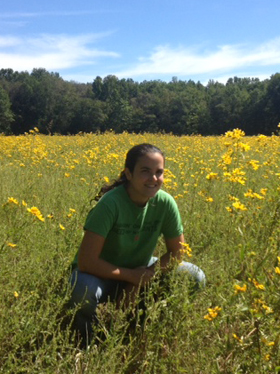 Jersey Farm Scribe here, on….
Jersey Farm Scribe here, on….
Putting Words on Paper
Sounds simple, doesn’t it? I mean, we’re writers. That’s what we do.
But most of us have been there… struggling to get to that next thought.
I may know what I WANT to happen, but I don’t know HOW to get there. I may know the tone I need to create, but can’t grasp the words to create it.
Or with no explanation I’m just… stuck on being stuck.
When clearing my mind isn’t enough…
It’s time for plan B….
Instead of letting my lazy-instincts take over and killing an hour or ten on Twitter or (insert your own social-media black hole here) I have a few things I do to break the cycle.
Review critique partners’ work: This keeps me in creative-mode, without focusing on whatever project is freezing me out.
Okay. Check.
Hmm… still nothing? No problem! There’s no greater excuse to curl up on the couch and….
READ READ READ! Important for ALL writers, I find it even more key for writing for children.
Reading for the target age group for my manuscript, keeps my brain thinking in the right rhythm. There is undeniably a pace, meter and natural ebb and flow to the way children’s brain’s take in their world. Reading the genre I’m writing, puts me in the right frame of mind.
Okay. I don’t think I can avoid it anymore. I have to go back to “that spot”.
Sigh. Okay. Fine! (slooooowly reopens the manuscript)
If I’m still hesitant to jump back in the first thing I try is….
Retreat. Regroup. And RE-WRITE:
Maybe the reason I’m stuck is because somewhere along the line, I took a LEFT when I should have gone RIGHT. I re-write the last section and make as many changes as I can think of. (I can always change them back later!)
If Bradley had pancakes, now he has cereal. If he rode the bus, this time missed it and was late for school. If Katie was after school for detention, this time it was because she forgot her math book.
A new lead-in can smoothly take me in the direction I wanted to go in the first place.
And other times…. Ugh. I’m right back where I started.
Okay…. deep breath.
First, I remind myself that thunking my head on the table will most likely not actually help.
Time to buck-up, straighten my shoulders and JUST WRITE!
Write anything.
Ignoring my next plot point, I’ll throw my character in a completely random situation. It can help with character development, and gets my pen on the paper!
I wrote an entire chapter about my character randomly being told the family was moving. It got pulled, but I learned more about how he reacts in stressful situations, and actually came up with some funny lines I worked into other places.
Does this break me out and spur an idea of what how to bring things together?
Well…. Sometimes.
If not… and I’ve done everything I can think of and gotten NOwhere…
Well then, I’m back to thinking that thunking my head may just be my best bet!
(Honestly just picturing it is frustrating!!)
AAAAAaarrgghh!!!!
This is incredibly discouraging, horribly painful, and unfortunately… just part of being a writer!!!
So what NOW???
There’s really nothing left to do accept…. FORGE THROUGH!
Time to write badly!!!
I use this when I know WHAT I need to write next, I just can’t figure out HOW. I know where my plot line needs to take me and I’ve done all the free-writing I can. I pick up the pen, and I write horribly (and I mean HORRIBLY).
I don’t worry about voice, or style. I don’t think about flow or if the reader will be confused. The more awkward, out of place writing, the better!
I’m like a Super-Villain from a new line of DC Comics. (oh yeah… I said it)
She uses run-on sentences and self-indulgent language to laugh in the face of all that is good and professional writing!
She’s — The Agent Repeller! MwaaahahahahaHA!
I KNOW that I can’t write well all the time. So sometimes, I just don’t even try!
I write through it. I put words on paper.
Eventually, often without me even realizing it, things have smoothed out and I’m back to my natural style and flow of words.
Everyone’s process for how to work through these situations is different. All that really matters is that we have SOME way to deal with it, and don’t let it get us down.
What we do is HARD. Whether it’s picture books or YA, we’re creating entire realities that children have to believe in and CHOSE to visit.
No easy feat for sure.
We have to trust ourselves. Know that the story is in there and we will find it.
If we don’t put words on paper… sometimes even ridiculous, embarrassing words that we’ll never show another soul… then there won’t be anything to work with.
Anything written, can be fixed. (Even if that means deleting 99 percent of it!)
It sounds so simple, but sometimes putting words on paper, is the toughest part of the job.
______________________________________________________________
Erika Wassall is a writer, a farmer and a liver of life. She is a member of SCBWI and a proud Mad Scientist, bringing science experiments right into children’s classrooms, and hearts. She has a small farm in New Jersey with sheep, chickens, pigs and vegetables. Check out her new website at www.TheJerseyFarmScribe.com where as a first generation farmer, she often takes the long way, learning the tricks of the trade on The Farm. On her website is also The Shop page with tips and a free Q/A from her husband’s mechanic shop, and The Writer page where she shares stories, experiences and characters from the heart. Follow her on Twitter at @NJFarmScribe. She’d love to hear from you!
Thank you Erika for another great post.
Talk tomorrow,
Kathy
Filed under:
Advice,
article,
Author,
How to,
inspiration,
Process,
Writing Tips Tagged:
Erika Wassall,
Jersey Farm Scribe,
Putting Words on Paper 

Jersey Farm Scribe here on the Road to Revising!
 Pen down.
Pen down.
You’ve DONE IT!!!
That’s right folks, you’ve written not only a beginning, but a middle and an end.
And it feels SooOOooO gooOooOood.
First… and please, don’t forget this step… give yourself credit. What you have done took talent and boatloads of commitment. You completed something most people only dream of even starting.
Get yourself a celebratory coffee/chocolate/wine/cupcake!
And then what?
First things first: DO NOTHING
WHAT? But I’m all giddy!! I want it to be perfect IMMEDIATELY!
Our manuscripts are worth the wait! Taking a step back for at least a week or two, sometimes as much as a month if I can stand it, gives a powerfully different perspective. Simone Kaplan Talks Revisions from RevIMo has some wonderful insight on this topic.
So it’s been a few weeks, and we’re ready to get started.
Read the manuscript completely, OUT LOUD.
While beneficial for any manuscript, this is especially important when writing for children. Forward Literary Agency has a thought provoking post by Pam van Hylckama Vlieg on its usefulness.
How does it feel rolling off the tongue? Is the dialogue natural? Are there inconsistencies or awkward spots?
Circle them, maybe jot down a note or two. But don’t linger! Come back later to play with them. For now, give it a cover-to-cover out-loud read.
And then, remind yourself, that’s YOUR BOOK you just read.
Whoo-hoo!
The Nitty Gritty
Now it’s time to get dirty! I scour over my manuscript looking for whole sections, concepts, sometimes even characters that can lift out. It’s amazing what I’ve found.
Darcy Pattison has an excellent post about her experience cutting down an already short picture book manuscript, when she realized she was telling the WRONG character’s story!
When in writing-mode, we allow the heartbeat of creativity to take us over; an important part of the process for sure.
But then it’s time to go back over every page, paragraph even word, and say, what happens if I remove this? Do I miss it? Do I really NEED it?
And that means… yup… we all knew it was coming:
Killing Your Darlings
A well-known saying that is for some, (like me!) often feared.
While this could easily be an entire post, Lisa Spangenberg words it so simply by saying “Style should serve the purpose of the text, not the writer’s ego.”
Sometimes our Darlings are pinnacles of style and make our manuscripts absolutely SING.
Other times? - Not so much.
The couple week step-back is helpful here.
Sometimes I’ll no longer understand why I was so attached in the first place! Or I’ll realize with that Darling, I was writing for ME, not my audience or the story itself. Then it’s time to break out the strikethrough!
Easier said than done of course.
But hey. We’re writers. We knew this wouldn’t be easy.
Which brings us to our next step:
Call in the Troops!
Good critique partners/groups are undoubtedly worth their weight in GOLD. No one is good at everything. It’s beneficial to have multiple people critiquing your work, some good at grammar, some at emotion, word count, consistency, etc.
Kid lit has a wonderful article on the tricky balance of What a Great Critique Partner or Group Means.
Keep in mind, being OPEN to anything is great. But you can’t, and shouldn’t take all the advice you are given.
Kathy Temean herself put it best when she critiqued one of my manuscripts and told me, “Always remember that it is your story and you should follow the vision that you have.”
Let people point out things to consider. DO consider them. But remember that they are critiques, NOT corrections.
The revision list is endless. But I’ll wrap up with this category:
Personalize Your Process
Maybe you’re good at word count, but struggle with getting to the conflict quickly, or excellent at character development, but overly descriptive.
Write down a physical list of your sticking points. It gives you something to refer to. AND you’ll find yourself increasingly aware of these concepts as you’re writing.
Here’s a few that might make it to your list:
Keep age in mind: Josh Getzler, agent and founder of HSG, in Agent Q & A: Revisions by Operation Awesome says that it’s one of the most frequent revisions he suggests. He often has to give direction on matching the age of the reader, with character age, plot, tone, etc.
Check your opening: If someone only saw the first 100 or 300 words, would they be HOOKED? Like Erin Harris, agent at Folio, mentions in that same Q/A article, this is where you’re selling yourself and your manuscript the MOST. If you’re not immediately hooked, perhaps you started in the wrong place.
Put lists in your list: Bruce Coville, author of the Unicorn Chronicle series, talks about how he keeps a list of words he knows he overuses so he can search for them later, in Cuppa Jolie’s great Wednesday Whip Tip.
And again, never forget that what you’ve already accomplished is something to celebrate!
As Erin Bartels discusses here, patience is really the name of the game.
Not easy. But worth it, because your manuscripts deserve to be treated right!
Erika Wassall is a writer, a farmer and a liver of life. She is a member of SCBWI and a proud Mad Scientist, bringing science experiments right into children’s classrooms, and hearts. She has a small farm in New Jersey with sheep, chickens, pigs and vegetables. Check out her new website at www.TheJerseyFarmScribe.com where as a first generation farmer, she often takes the long way, learning the tricks of the trade on The Farm. On her website is also The Shop page with tips and a free Q/A from her husband’s mechanic shop, and The Writer page where she shares stories, experiences and characters from the heart. Follow her on Twitter at @NJFarmScribe. She’d love to hear from you!
Thank you Erika for another great post.
Talk tomorrow,
Kathy
Filed under:
Advice,
article,
How to,
Process,
Writing Tips Tagged:
Darcy Pattison,
Erika Wassall,
Revisions 


By:
Robin Brande,
on 4/27/2014
Blog:
Robin Brande
(
Login to Add to MyJacketFlap)
JacketFlap tags:
Summer Camp,
Home Projects,
Life List,
Inspiration,
How To,
Fulfillment,
Creating a Life List,
Writing,
motivation,
Getting Things Done,
Goals,
Happiness,
Add a tag
You never know when you might “accidentally” be inspired in a very large way by a stranger you meet at the dentist’s office.
We were both early, waiting for our cleanings, I was reading a book and she pulled out her knitting. I said, “Oh, isn’t that so relaxing? I used to love knitting.”
“It’s like a meditation,” she agreed.
“I only know how to knit,” I said. “I never learned how to purl.”
“You could take a class,” she suggested. She asked what part of town I live in, and told me about a knitting store nearby.
And that’s when it got interesting.
Because she told me that for the past few years, she’s made a point of taking classes in all the things she’s ever wanted to learn: ballroom dancing, horseback riding, knitting, etc. But here’s the key: she fully commits to learning whatever it is, but only for one month. And at the end of that month, she moves on to something else.
Back up for a second. I’m familiar with Life Lists. I made one for myself about fifteen years ago, listing all the places I wanted to go, the new skills I wanted to learn, the other changes I wanted to make. It’s why I finally ended up writing my first novel. And also seeing a real Broadway show, learning martial arts, going on a Jane Austen tour in England, and all sorts of other interesting things.
But this woman, Danetta, took the Life List concept and made it better. Simply by putting a time limit on the things she was going to try.
She started the way a lot of us do, making an exhaustive list of absolutely everything she’s ever wanted to do and to learn and all the different trips she wanted to take. After that “brain dump,” she had a list of about 100 items. Big things from exotic travels to little things like getting a pedicure. Anything that sounded interesting or fun made it onto the list.
Next she organized her list into several categories: Health & Fitness; Travel; Friends & Family; Home; and Personal Growth/Learning Adventures. (I love that term learning adventures!) Then she made herself a schedule.
She knew if she wanted to try as many things as possible during the year and still give herself sufficient time to enjoy each activity, she could commit one full month to whatever she wanted to do. Twelve new activities every year, and they could be from any of her categories.
So one month she might tackle some home project she’d been meaning to do, and the next month she might take Czech lessons or hike as many miles as she could.
In the Friends & Family category, she made a list of all the friends and members of her extended family that she wanted to see more often, and made a rotating schedule of lunches, holiday gatherings, and other ways she could guarantee she kept in touch with all of them throughout the year.
In the Travel category, maybe she couldn’t take a big trip that particular month, but she could do all the research for it: look up airline prices, look for hotels, study a little of the language if she were going abroad.
And if it turned out at the end of the month that she had had her fill of a particular activity–like reading the Classics (because face it, a little of The Iliad and The Odyssey goes a long way)–she could move on knowing she had done it, tried it, and could check it off her list.
But if it turned out to be an activity she loved, like writing a novel, she could add it to her life more permanently.
It reminds me a little bit of Gretchen Rubin’s book The Happiness Project: Or, Why I Spent a Year Trying to Sing in the Morning, Clean My Closets, Fight Right, Read Aristotle, and Generally Have More Fun . The difference is that Gretchen picked themes for every month, like working on her marriage, being a better parent, learning to have more fun in her life, and then worked on the whole category. I prefer Danetta’s strategy of choosing just one item on her list and really devoting herself to that. It seems easier and more doable.
. The difference is that Gretchen picked themes for every month, like working on her marriage, being a better parent, learning to have more fun in her life, and then worked on the whole category. I prefer Danetta’s strategy of choosing just one item on her list and really devoting herself to that. It seems easier and more doable.
And you just gotta love that whole short-term commitment thing. Get in there, try something in an intense, concentrated way, then move on. Yes, please.
I’ve done something similar by pretending every summer I’m sending myself to summer camp. I pick a few skills or crafts I want to try–like learning archery or how to make fire from scratch, or taking a beginning drawing class–and that’s something to look forward to when the temperatures here reach 117. At least I can go play at something for a while. Preferably somewhere that has air conditioning.
This summer I’m going to learn how to make lotion from scratch. I’ve already found a bunch of instructional videos on YouTube, and that will be my project for July. I might also take a sewing class. Who knows? I haven’t exactly decided on my themes for camp this year.
So there’s some inspiration that I’m happy to pass along to you. And it comes at a great time, since we’re about to enter a brand new month. What do you want to do with the remaining 8 months of this year? If you create your own list of everything you’ve ever wanted to do and try and learn, which 8 things could you start giving yourself right away?
And as always, if not now, when?

By:
Robin Brande,
on 4/20/2014
Blog:
Robin Brande
(
Login to Add to MyJacketFlap)
JacketFlap tags:
Reading,
Adventure,
Confidence,
Writing Life,
Writing,
Inspiration,
Learning,
Psychology,
How To,
Norman Vincent Peale,
Jean Houston,
Overcoming Shyness,
Behavior Modification,
BB4G,
Becoming Your Best Self,
Living a Full Life,
The Possible Human,
Add a tag
I’m reading two great books right now by Jean Houston: The Possible Human : A Course in Enhancing Your Physical, Mental, and Creative Abilities and A Passion for the Possible: A Guide to Realizing Your True Potential
and A Passion for the Possible: A Guide to Realizing Your True Potential .
.
The premise of both is this: We’ve heard all our lives that we’re only using a tiny fraction of our brains, but then . . . we just accept that and move on. Why not instead retrain ourselves to use more of the hidden brain? Why not make the effort to access more of our potential in thought and behavior?
The thing I love about her books is she doesn’t make it hard. You don’t have to go to some boot camp of personality reconditioning where you sort out all your problems and your flaws and then sweat your way through getting rid of them.
Jean Houston’s books are relaxing. Her mental and visualization exercises are some of the best I’ve ever read and tried. I’ve turned other people onto her books, and they agree: it’s all so easy. And fun and (here’s that word again) relaxing. I’m into any self-improvement that makes me feel like I’ve been at a mental spa for half an hour, or even for five minutes. And some of her exercises take that little time.
One of my favorite visualization exercises of hers is walking up to a giant oak door that has a sign above it saying Room of the Skill. Deciding what skill you’d like to learn in there, then entering and feeling it in the air all around you. Maybe you’d like to learn to play the violin. You enter and violinness is already sealed into that room, and it starts seeping into your pores and you breathe it in and it sticks to your hair and it soaks into your bones.
There are other parts of the visualization that are important to gaining the skill–and I urge you to read the books to really get the full power of them–but I really love just that opening image of It’s already here. You’re already getting it. You don’t have to wait.
I’ve mentioned before my experiments in getting over my fears by just postponing when I want to feel them. The Jean Houston books open up another way of becoming what she calls The Possible Human. And what we’ll call The Possible You.
Let’s say you believe you have certain personality and physical traits: you’re shy. You’re not good at sports. You get angry easily. You’re a slob. You overeat. Whatever it is, I’m sure you could make up a list of four or five things right now with no effort.
What if you just decided Not anymore? And what if you also decided that there didn’t have to be any steps in between now and that next thing. You could just stop what you were doing before and start doing the new thing right now, right away, just decide.
Years ago I read a story in some Norman Vincent Peale book about a salesman who was having a really hard time. He couldn’t meet his sales goals, he felt awkward and ineffective around people–he was, in short, a failure.
And he got tired of that. Got tired of constantly having to stress over his paycheck and his bills, got tired of feeling so inadequate at a job where he actually meant to do well.
So one night he came home from another unsuccessful day on the road and decided That’s it. Enough. He peeled off his unsuccessful suit and took a bath. And decided during that bath that when he stepped out, he was a new man.
He threw away the old suit. Went out and bought a new, successful one (not expensive, just new. Different). And without waiting to go through some 9-step program of becoming a successful salesman, he just was one. He decided. He started behaving the way a successful salesman already does. No explanation to people who saw the change, no need to announce it to the world, just Do. Go. Be him.
By the end of the year he was the top salesman in the region. It looked like magic, but it was really just change. Deciding and then changing–right away.
I’ve done that, too. There was a time in my life when I got really tired of feeling shy. It was making me feel bad in social situations and even just stepping out my door into the world. I didn’t like it. It was a bad habit I’d picked up somewhere in my childhood, and I’d acted like it was just the way things were for the next however many years.
But one day I just told myself, “I’m not shy anymore.” And then in every single situation from then on, I made all my decisions based on that new law. I’d smile at people. Be friendly. Laugh when I felt like it. Little moments all day long, every day, when I let myself be different than I had been for years and years.
And what was key to pulling that off was I didn’t feel the need to explain the change to anyone. I got to skip all the steps of changing a little bit one day, a little bit more the next. I was like that salesman taking a bath and coming out a new person.
If anyone did ask me about the difference, I’d just say, “I’m not shy anymore” and move on. People don’t really need more explanation than that. They’re usually too busy thinking about their own lives.
I’ve also done the experiment with physical skills like athletic pursuits. Instead of telling myself “This is hard! It’s going to take a long time to learn this,” I’ve practiced just already being good at it. Letting it come easily instead of going through the performance of pretending to myself it’s difficult.
So much of what we do when we hold ourselves back really is performance. It’s theater. We’re so comfortable in our role of being shy, awkward, bad at math, a bad cook, bad at sports, ugly, scared (fill in your own blank) we just keep playing that part without ever realizing it’s only a part.
But if instead you start picturing The Possible You, the one who looks a certain way, is confident, has awesome skills, is friendly and happy (fill in your own blank), and then you just go ahead and begin being that version of you, right now, no middle steps, no announcements to the world–isn’t that a much better way of evolving into the next stage of you right now? Isn’t it time? Why do you have to wait?
In a way, it’s reverse-engineering your life. You think about how you’d like to be when you’re 80 or 60 or 19 or even a week from now, and rather than just hope you’ll turn out that way, you go ahead and become that right now. Skip all the time and skip all the steps.
The only steps you really do need to take are behaving the way that version of you behaves. Every moment of every day. And that includes reading the books that person reads, spending time with the people that person loves to be around, maybe taking the classes that person takes to learn the skills he or she loves to have.
And it means changing the things you hear yourself say. Because your ears are hearing it and your brain is taking it in. When you make a new choice and hear yourself say, even if it’s in a whisper just to you, “That’s right, because I’m not shy anymore,” it solidifies that new Possible You that you’ve become. Not “are” becoming, but “have become.” Because you already did that the moment you decided.
Why have I written this entire essay? For a couple of reasons: I’m not shy anymore. I love sharing my experiments and experiences with others. I’m completely confident writing in public and letting other people see my work.
I wasn’t always that way. But then I decided.

By: Kathy Temean,
on 4/13/2014
Blog:
Writing and Illustrating
(
Login to Add to MyJacketFlap)
JacketFlap tags:
reference,
Queries,
How to,
demystify,
Carol Schulman,
Leslie Zampettis,
Links to resources,
Rear in Gear,
Writing Tips,
list,
Add a tag

This illustration of the cute girl with pink glasses above was sent in by Carol Schulman. She is the author of two books on art, both now represented by Schulman Literary in NY. The first, “The Creative Path: Process and Practice” is a look at creativity from philosophical, psychological and practical points of view. The sequel: “Art Smarts: A Book to Help You Become a GR8 Artist” is a sequel for children. See more at: http://www.carolynschlam.com/Art_Pages/Illustration/Illustration_info.html
Leslie has been focusing on querying agents and looking for places that had good information about navigating this process. She decided to share some resources she gathered from various writing friends on her blog “Rear in Gear”. She says, “I’m always thankful for their help, and thought I’d pay it forward in a small way.”
Queries Not Questions
Here is Leslie’s list, in no particular order:
AgentQuery
Chuck Sambuchino’s Guide to Literary Agents
Successful Queries (a subsection of the above guide)
Preditors and Editors
Publishers’ Submission Guidelines
JacketFlap
SCBWI BlueBoard
8 Steps to Finding the Right Agent
Critiquing First Pages and Queries
10 Questions to Ask an Agent
Kidlit.com – Queries
How to Write the Perfect Query Letter
Query Shark
Query Tracker
Writers Market *This is a subscription service. IMHO, well worth it.
Children’s Writer Newsletter *Another subscription service. Articles often contain market bib biographies, and every issue contains market profiles. Also well worth it.
-
 Leslie Zampetti has had stories published in online children’s magazines and is now querying agents for her middle grade fantasy novel. A childhood spent in Florida has this transplanted New Yorker frequently dreaming of sunshine – but she enjoys the whirl of the city and its riches, not least of which is the New York Public Library.
Leslie Zampetti has had stories published in online children’s magazines and is now querying agents for her middle grade fantasy novel. A childhood spent in Florida has this transplanted New Yorker frequently dreaming of sunshine – but she enjoys the whirl of the city and its riches, not least of which is the New York Public Library.
According to most successful authors, the best way to succeed is to plant your tushy in your seat and write. Leslie’s been doing that for some years now and is beginning to see the seeds of her labor blossom. Interested in knowing more? Stop by her blog, “Rear in Gear,” at http://zampettilw.wordpress.com.
Thank you Leslie to sending this to me. It is nice to have a list and it is nice that you were willing to share the wealth. I am sure everyone will bookmark this one.
Talk tomorrow,
Kathy
Filed under:
demystify,
How to,
list,
reference,
Writing Tips Tagged:
Carol Schulman,
Leslie Zampettis,
Links to resources,
Queries,
Rear in Gear 


By:
Robin Brande,
on 4/13/2014
Blog:
Robin Brande
(
Login to Add to MyJacketFlap)
JacketFlap tags:
Inspiration,
Romance,
Nature,
Dogs,
Butterflies,
Abundance,
Happiness,
Contemporary Romance,
Women's Fiction,
Lawyers,
How To,
inspiring women,
Backpacking,
Outdoor Adventure,
Legal Fiction,
strong women,
Contemporary Women's Fiction,
Flourish,
Female Lawyers,
Women Lawyers,
BB4G,
Abundance Mentality,
Abundance Thinking,
Attorneys,
Female Attorneys,
Flourish List,
Law Romance,
Lawyers in Love,
Legal Romance,
Poverty Mentality,
Women Attorneys,
Reading,
Adventure,
Writing Life,
Add a tag
Now that I’ve outed myself as the secret author of books by Elizabeth Ruston, I can freely talk about one of the concepts in the book Love Proof.
We writers always hear “Write what you know!” Well, I’ve known many of the things I wrote about in Love Proof, including the life of a striving law student, the beginning uncertain years of practicing law, the sometimes disgusting personalities of some of the lawyers you have to deal with, and yes, even the unexpected excitement of accidentally falling in love with your opposing counsel. Yeah, that happens.
But I’ve also known the kind of poverty Sarah Henley experiences in the book. And that was really interesting for me to write about, because I know I still have some vestiges of that poverty mentality deep inside my brain. And I have to actively make choices to move myself past that way of thinking.
One of the things Sarah does in the book to deal with her own poverty mentality is to create a Flourish List. It’s an idea that came to me a few years ago, and something I tried for myself before ever putting it into my fiction.
The name comes from both definitions of flourish: “an extraneous florid embellishment” (or as Sarah puts it, “something I want, but don’t actually need”), and “a period of thriving.”
I don’t know about you, but at times I am MUCH too stingy with myself. I call it frugality, but sometimes it’s just being harsh for no great reason. Perfect example from last night: I was down to maybe the last half-squeeze on my toothpaste tube, and I could have forced out that last little bit, but I decided to make a grand gesture of actually throwing it away–that’s right, without it being fully empty (call the frugality police, go ahead)–and treated myself to a brand new tube. I’ve had to give myself that same permission with bars of soap that have already broken into multiple parts that I have to gather together in a little pile in my palm just to work up a decent sud. Lately, out they go, fresh bar, and if I feel guilty, I know it will pass.
So where did this new radical attitude come from? A few summers ago while I was backpacking in a beautiful section of the South San Juan mountain range in Colorado, I had an afternoon to myself when I sat out in a meadow, my faithful backpacking dog at my side, while my husband took off to fish. And as Bear and I sat there looking at the small white butterflies flitting over the meadow flowers, the thought occurred to me that those butterflies were not strictly necessary. Not in their dainty, pretty form. They could have been ugly and still done the job. Or they could have left their work to the yellow and brown butterflies–why do we need the extra? But having pretty white butterflies is a form of nature’s flourish.
And that led to the companion idea that if flourish is allowed in nature, wouldn’t it be all right to have some of it in my own life?
So right then and there I pulled out pen and paper and started making my Flourish List. Spent an hour writing down all the things I’d wanted for years and years, but never allowed myself to have. I’m not talking about extravagances like a private jet or a personal chef, I’m talking about small pleasures like new, pretty sheets (even though the current ones were still in perfectly good shape); new long underwear that fit better; a new bra; high-quality lotion from one of the bath and body shops; fancy bubble bath. The most expensive item on my list was a pillow-top mattress to replace the plain old Costco mattress we’d been sleeping on for the past twenty years.
I gave myself the chance to write down everything, large or small, just to see it all on paper. And you know what? It wasn’t that much. I had maybe fifteen items. Then, still sitting out in that meadow, I did a tally of what I thought it would all cost. I knew the mattress would probably be very expensive, so I estimated high (no internet connection out there in the wilderness, otherwise I could have researched actual numbers). I think I ended up estimating about $3,000 for the whole list. And that sounded pretty expensive to me. So I just put the list away and promised myself I’d start buying some of the cheaper items when we got home.
And I did. New underwear. Vanilla lotions and bubble baths. New sheets. And finally, a few months later, a pillow-top mattress, on sale, less than $400. By the time I checked off the last item on my list last fall, I had spent less than $1,000. That might still sound like a lot, but in the greater scheme I felt like it was too small an amount to have denied myself all those little pleasures all those many years. Especially if I had bought myself one of those items every year–I know I never would have noticed the cost.
So that’s my suggestion for today: Create your own Flourish List, just like Sarah and I have, and give yourself the pleasure of writing down every small or large thing you want for yourself right now. All the little treats. Maybe they’re not so little–maybe this is the year you need a new car or some other big-ticket item. But that’s a “Need” list. This is your Flourish List–everything you want but don’t necessarily need.
And then? Treat yourself. Choose one item every week or every month, and give it to yourself. And if you feel strange about replacing something you don’t like with something you know you will, then remember to pass on that other item to someone else who might love it more than you did. I’ve done that with clothes, kitchenware, books: it feels so good to take everything you don’t want and give it to a thrift store where someone else can be happy to have found it, and found it so cheaply. Maybe there’s someone out there with a Flourish List that includes a pair of boots like the ones that have just been gathering dust in your closet. Stop hoarding them. Move them on to their new, appreciative owner.
And by doing that, you make room in your own life for things you’ll appreciate and enjoy. It’s hard to invite abundance when you’re chock full of clutter. Make some room. Make your list. And then start treating yourself the way you deserve by no longer withholding those little items that you know will make you smile.
I felt pretty great throwing out that nearly-empty tube of toothpaste last night. It doesn’t take much to make me happy. But I didn’t really realize that until I sat in a meadow and enjoyed the simple sight of some unnecessary butterflies.

By:
Robin Brande,
on 4/10/2014
Blog:
Robin Brande
(
Login to Add to MyJacketFlap)
JacketFlap tags:
Food,
Health,
Recipes,
Nutrition,
Eating,
Spring Cleaning,
Smoothies,
How To,
Wellness,
Green Smoothies,
Smoothie Recipe,
Fruit Smoothies,
Green Smoothie Recipe,
Nutribullet,
Recovery Foods,
Sports Recovery Foods,
Spring Cleaning Foods,
Spring Cleaning for Your Body,
Add a tag
As you may have been able to tell from my recent photos and posts, I was skiing up until a few days ago. Just arrived home to the desert where it’s already 92 degrees. It’s a little . . . jarring. Dogs are looking at me like, “What the–?” and while they’re busy shedding as much of their fur as possible–I’ll be able to knit a new Labrador in about a week–I’m taking my own measures to adjust to the almost summer.
It’s a two-phase action plan: Clean my house, clean my body.
Believe it or not, the body part of it is much simpler. All I have to do is switch out of winter eating mode (soups, sandwiches, pastas, sweets, sweets, more sweets) and turn to my old friend the green smoothie.
Also known as Baby Poop.
Why Baby Poop? Because if you saw the way one of my green smoothies has traditionally looked–dark brown, sometimes brownish-red, with hints of green flakes–you’d say, “Yeah, good luck with that, think I’ll have a salad.” But for some reason, I’ve been out of the salad mood for about a year now. Can’t explain it. So I’m just going with it.
The thing that’s going to banish the baby-poopedness look of my smoothies from now on is that tomorrow I’ll be getting this nifty machine that actually has a proper motor. I discovered while skiing that that’s been the whole problem with my green smoothie life. I just haven’t had enough power.
I made that discovery by watching someone else make one for me. The things she put in there! (To be discussed below.) And by the time she poured it into a cup, the liquid was this beautiful, light green, and instead of tasting gritty and *good for me,* it tasted smooth and delicious, more like a dessert. Which, see above re: winter diet, sold me.
But even better, the smoothie fixed me. Day after day I’d stumble into that place, start croaking out ingredients–”Dates! Cashews! Oh my gosh I’m about to pass out–coconut! More fat! Bring it!”–and the lovely proprietoress, Gretchen, would keep adding and adding (see below) and then give me basically a cup full of green medicine.
I have never recovered from a big physical effort more quickly and more deliciously. That’s what I’m saying. That’s why I’m trekking down the Green Smoothie Way.
I’ll be experimenting with new recipes as I go, and I’ll post some of the best ones here, but let’s start with the Skiing Kicked My Butt recipe that got me through:
- Big handful of unsalted cashews
- Normal handful of unsalted sunflower seeds
- One heaping teaspoon peanut butter
- Big handful of dates (about 5)
- One banana, preferably frozen to give the drink some thickness
- Big handful of strawberries, also preferably frozen
- Normal handful of blueberries (optional–makes the color a little weirder, but tastes good)
- Two heaping teaspoons cacao (unsweetened cocoa powder will do) (also optional, but wow)
- One teaspoon coconut (optional, but yum)
- Three huge leaves of kale or Swiss chard, stems and all, ripped into pieces and layered on top
- About 1/2 to 1 cup of peach, pear, or apple juice
- About 1 1/2 cups pure water–start with 1 cup, then add more as you assess the thickness. Some people like their smoothies thicker, some more liquidy. You’re the boss.
I tried this in my regular blender, but no. Baby poop. I’ll take a photo of the proper green smoothie once I try it with my new machine tomorrow. You’ll see. Fresh and spring-looking.
Onward, green smoothiers!

By: Kathy Temean,
on 4/8/2014
Blog:
Writing and Illustrating
(
Login to Add to MyJacketFlap)
JacketFlap tags:
Agent,
Advice,
authors and illustrators,
How to,
Questions and Answers,
demystify,
Asking opinion,
Ask Kathy,
Julia Rosenbaum,
Publishing Industry Answers,
Add a tag
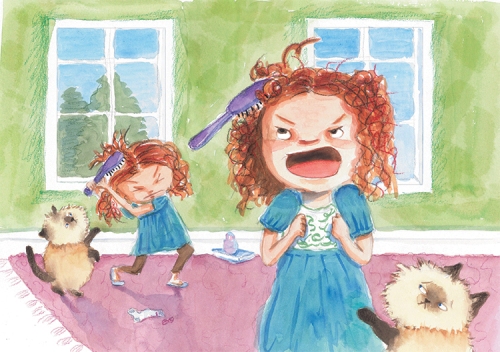
For all you writers and illustrators who have days where you feel like the publishing industry could make you stop, scream and pull their hair out, this cute illustration sent in by Julia Rosenbaum is for you.
Julia has always wanted to be a children’s book writer/illustrator…and so she went to law school. A few years after that interesting episode in her life, she learned how to use Photoshop and became a graphic designer. She is now working on her original dream: writing picture book manuscripts and creating illustrations. You can find her online at juliadraws.com and on Twitter @julia_draws.
Here are a few more Answers to the Questions you sent in and the answers from the Writer’s Retreat the other weekend with Agent Sean McCarthy and Associate Publisher at Penguin Putnam, Steve Meltzer.
1. Because agents now often don’t respond if they aren’t interested in a query, that makes almost imperative to send simultaneous queries. Is ten to a dozen too many to send out at once?
The consensus was to send ten queries at a time. No one thought you should send one query at a time and wait to hear back before sending your work out to someone else. Here are my thoughts about other similar questions I get asked: You may get five agents asking to see your full manuscript from the query letters you send out. Some may ask for an exclusive submission. If they do, you will need to way their request against the other agents. That exclusive submission request might throw that agent out of the running or they might be at the top of your list of agents you would want to represent you. If they are, then make sure you find out how long they expect to have an exclusive for your manuscript.
Is this amount of time acceptable? It may be, but now you know how to proceed. I personally think six weeks would be my limit, other people may be willing to wait three months. As long as both of you are on the same page it should work.
What if you send out your full manuscript to five agents or editors and one gets saying they are interested, before you say yes to them representing you and blow off the others, you should email saying you haven’t heard back from them and another agent is interested in offering you representation. Many agents appreciate you letting them know so they can pull your manuscript out of the pile to see if they are interested in your story. No need to do this if an agent stated up front that if you haven’t heard back in three weeks they are not interested.
Say you submit to an agent who turns around and works with you, offers a lot of advice that you use when revising your manuscript, and asks to see it again, IMO, you should make sure you resubmit the manuscript to them, before offering it to another agent.
If you have submitted the manuscript to editors, you should always make sure the agent offering representation knows who has seen it right up front. You don’t want to get in the position of signing a contract with the agent and then have them say they didn’t know it had been read by numerous editors in the industry. They might be thinking they could sell it to the same people you already sent it to. Now you have someone who doesn’t want to work with you and may even cancel the contract with you. Supposed this happens after you have turned down another agent who was interested in your work. Now you have lost out on two agents at one time. Oh yes, this can happen and it doesn’t matter if the agent should have asked these questions, you are now the one who is on the losing end of this scenario.
2. What’s the best way to label a manuscript/book that falls on the borderline between middle grades and young adult? (Think ages 10 to 14. For example, I’m talking about a horsey book, and that is the age at which the most girls are the most horse-crazy, and the best time to market such a book to them.) Would agents/editors want to see it called upper middle grades? Tween?
Sean McCarthy and Steve Meltzer said don’t put MG or YA in the query, put the age group and let them decide where it fits. The other idea you can use is to go to the book store and peruse the shelves. Where would the store shelve your book? What are the titles of the other books on that shelf? You could include a couple in your query letter.
3. What amount of books do you need to sell to have a publisher think your book was successful?
The general number was 20,000 copies, but it could be lower. It depends on the amount of your advance and the projected amount of sales the publisher expects after all there meetings and calculations. As Steve pointed out, a publisher who expects to sell a million copies of a book and only sells 600,000 copies might consider that book a failure. While a book that they projected 10,000 sales and sells 20,000, might be considered a great success.
4. I read on your blog to only use one space between each sentence in your manuscript. I had someone tell me they have asked editors and were told it was okay. Would you double check with Sean McCarthy and Steve Meltzer on this?
I did and both said it would not stop them from reading your manuscript. But I will not tell you that not doing this is okay, because I am trying to get you to do things according to the standard. My goal is to tell you how to do things that will make sure no one will find fault with. If 50% or even 20% of the editors and agents could pick up your manuscript and go on to the next on sitting on their desk because of the extra space, then I say, “Let’s do it right, so you are only judged on the content of your writing.” Over the years, I know little things can make a big difference.
5. I never heard of using capital letters the first time a character is mentioned in a synopsis. Would you ask about that at your retreat?
This is another one that would not stop Sean and Steve from reading your synopsis. I had said that I didn’t think this was a deal breaker when I told you how to format your synopsis, but again that is the standard. It makes it easier for the editor or agent to read, which shows you care about them and that you approach your writing as a professional who knows the industry.
Talk tomorrow,
Kathy
Filed under:
Advice,
Agent,
Asking opinion,
authors and illustrators,
demystify,
How to Tagged:
Ask Kathy,
Julia Rosenbaum,
Publishing Industry Answers,
Questions and Answers 


By:
Robin Brande,
on 4/7/2014
Blog:
Robin Brande
(
Login to Add to MyJacketFlap)
JacketFlap tags:
Adventure,
Inspiration,
Strong Girls,
How To,
Amy Poehler,
Smart Girls,
strong women,
Videos That Make Us Happy,
Amy Poehler's Smart Girls,
Science and Stunts,
Smart Women,
Stunt Men,
Stunt Ranch,
Stunt Women,
Stunt Work,
The Science of Stunt Work,
Thrilling Lifestyles,
Add a tag
Come on, who hasn’t? Even in your pretend alternate life? We can be honest here.
Here’s a short video to whet your appetite, courtesy Amy Poehler’s Smart Girls. (I’ve become obsessed with Amy’s website and all her many videos, so I can promise this won’t be the only one you’ll see. But it’s a fun place to start!)

By: Kathy Temean,
on 4/4/2014
Blog:
Writing and Illustrating
(
Login to Add to MyJacketFlap)
JacketFlap tags:
Interview,
picture books,
inspiration,
Process,
authors and illustrators,
How to,
Cartoon Network,
demystify,
Illustrator's Saturday,
Gideon Kendall,
Add a tag
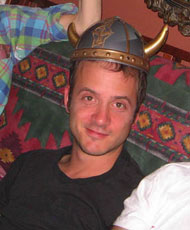 Gideon Kendall was born in Austin, Texas and spent his childhood on a commune deep in the backwoods of West Virginia. He attended high school in Philadelphia, PA and moved to New York City to attend art school. Since receiving his BFA from The Cooper Union in New York City (1989) he has been working as an illustrator, animation, designer, and musician in Brooklyn, NY.
Gideon Kendall was born in Austin, Texas and spent his childhood on a commune deep in the backwoods of West Virginia. He attended high school in Philadelphia, PA and moved to New York City to attend art school. Since receiving his BFA from The Cooper Union in New York City (1989) he has been working as an illustrator, animation, designer, and musician in Brooklyn, NY.
Gideon was the production designer (backgrounds) on “Pepper Ann”, a Saturday morning cartoon show on ABC. For five years (the duration of the series), he was the production designer (backgrounds) on “CODENAME: Kids Next Door” on the Cartoon Network. He has also designed backgrounds, props and characters for many other television shows, including Robotomy, Stroker & Hoop, Chuggington and Word World.
Gideon has illustrated articles and record covers for companies such as The New York Times, Puma, Children’s Television Workshop, Scholastic, Geffen, and College Music Journal. He has exhibited his artwork at a variety of galleries including Ethan Cohen Fine Arts and PS122 in New York City.
Gideon has been involved in many musical/performance art projects, and has toured the country with his band, Fake Brain. The band also wrote and performed the theme song for “The Kids Next Door” on Cartoon Network. Most recently he wrote, performed in, and created sets and animation for a multimedia comedic performance entitled “Dr. Wei-Wei & The Fake Brain” which was performed at The Bowery Poetry Club in New York City in 2006. His current project, The Ditty Committee, performs regulary in and around New York City.
Here is Gideon showing and discussing his process on his book cover, ELLIOTT and the LAST UNDERWORLD WAR:
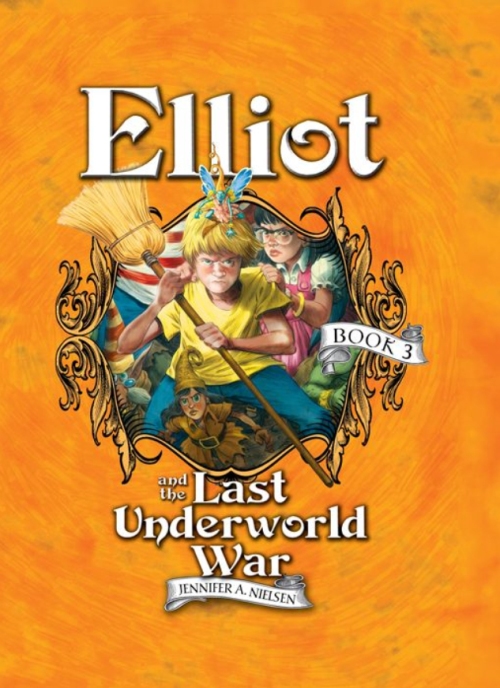
The image is entirely digital. It took probably about 3 days total, but of course it was spread out over weeks of approvals, edits, etc.
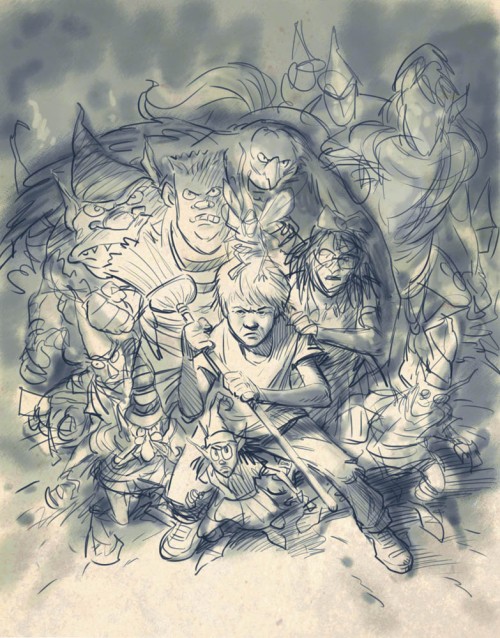
This is the rough, obviously. Just trying to sell the editor on the basic idea and work out for myself the composition and lighting. I always use tone on my sketches because I need to get a sense of the lighting. Light and shadow are essential for both clarity, focus, and drama. In the story, Elliot, the main character uses a magic glowing broom at a crucial point in the story. This was a great device for lighting this scene.
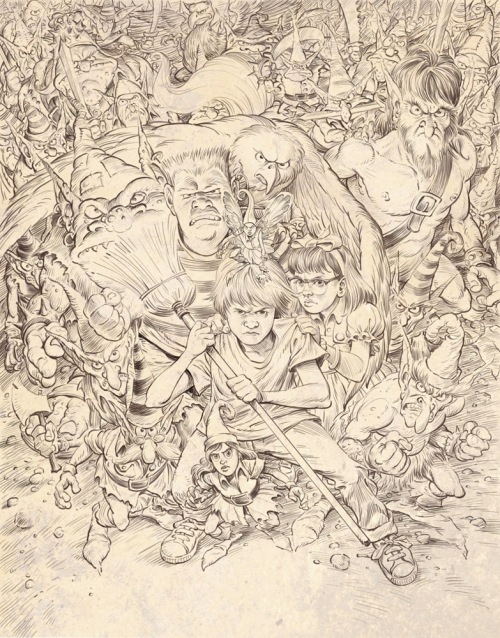
Here is where I set aside the lighting for the most part and focus on delineating the image. Although I love getting carried away with details and hidden jokes I try not to loose focus on the characters. Sometimes this comes easy. Other times not so much. The peripheral characters fell into place with little effort but I really struggled with aspects of Elliot. Finding that sweet spot of anger and determination while still keeping him cute was a challenge and I also had a hard time with getting his hands and arms right. I had my wife take pictures of me in the pose to help get it right and I still struggled.
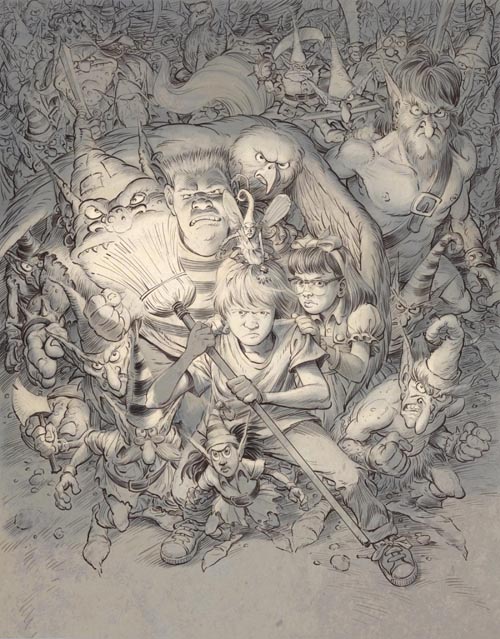
Now I introduce the lighting. This layer may or may not be used in the final art, but either way it helps me to finalize the composition.
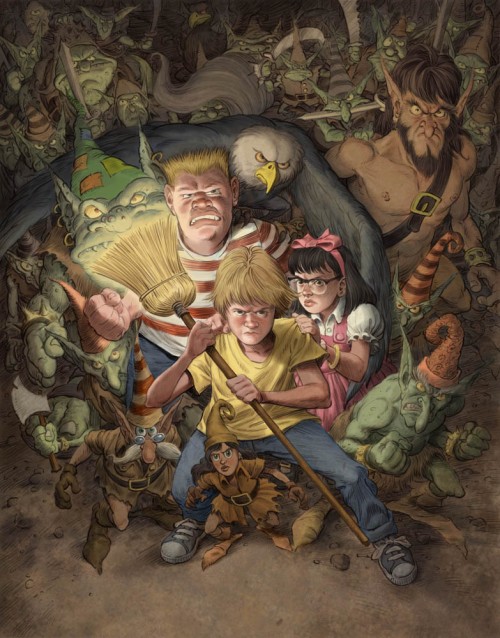
At this point I change the line drawing into a multiply layer and put it on top. I hide the tone layer and work up the color to a near-final state.
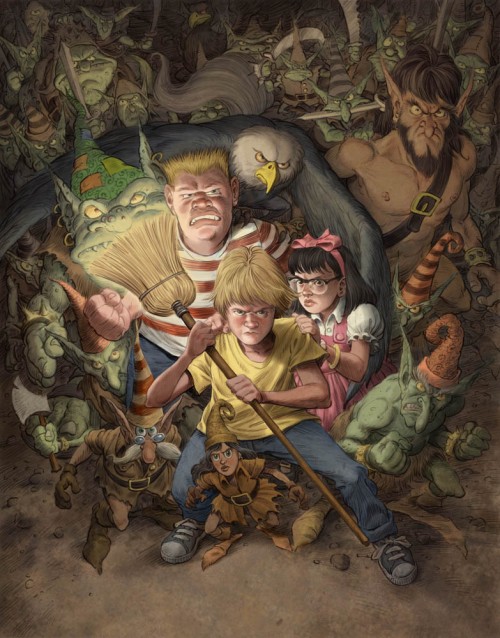
Then I add a layer of highlights on top of the line layer.
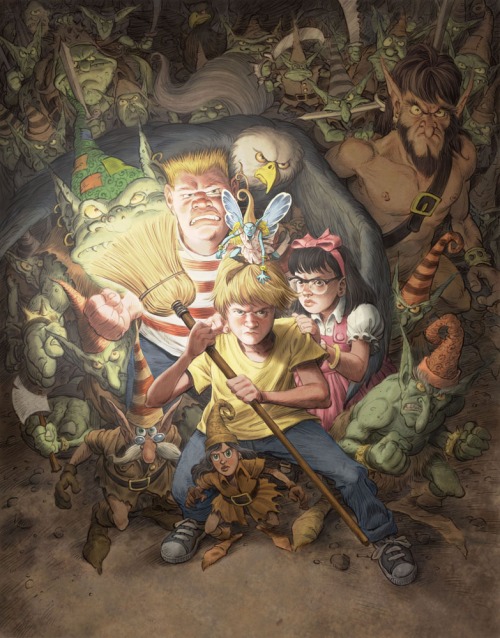
I kept the image of the pixie as its own element so that I could control her luminosity separately. I do her line work, color, and rendering and then balance her against the glow of the broom.
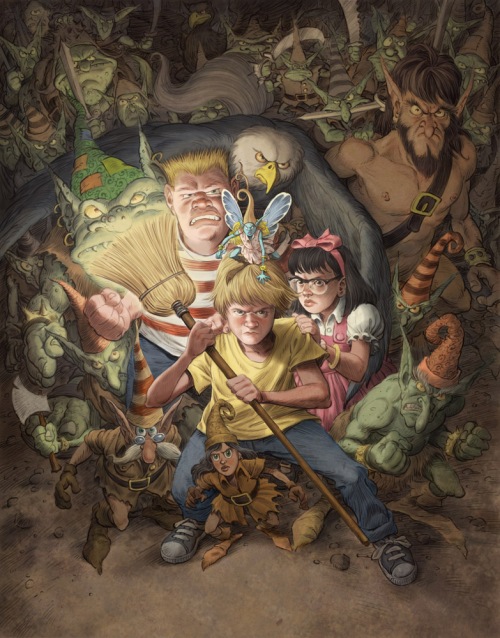
I wasn’t pleased with the way the broom was looking so I made a new drawing of it and colored it in a way to give it bit more 3-dimensionality. I refined the highlights and played around with the luminosity of the broom, and then I was done.
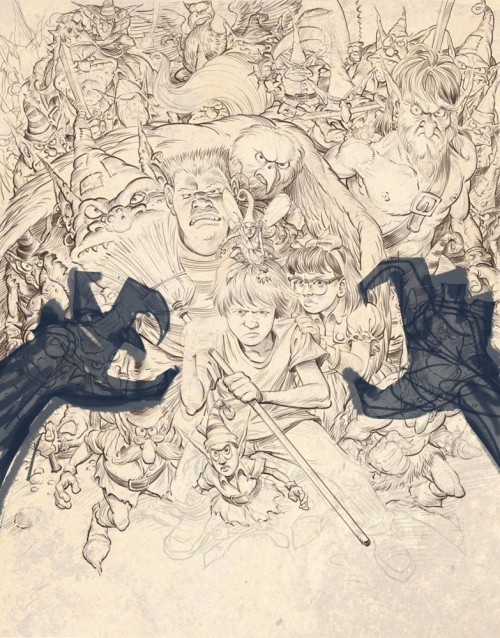
Early on in the process I played around with having the demon’s claws in the picture, thinking it might heighten the sense of confrontation. The editor thought it complicated things unnecessarily and I don’t disagree.
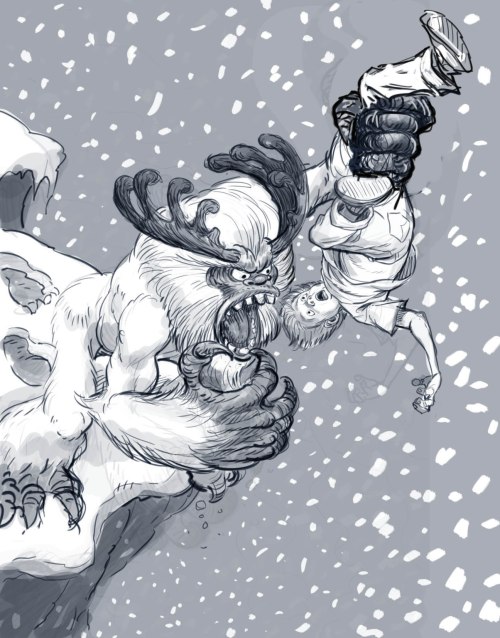
Just for kicks, an earlier cover sketch. This snow monster was removed from the story so I had to start over. Probably for the best.
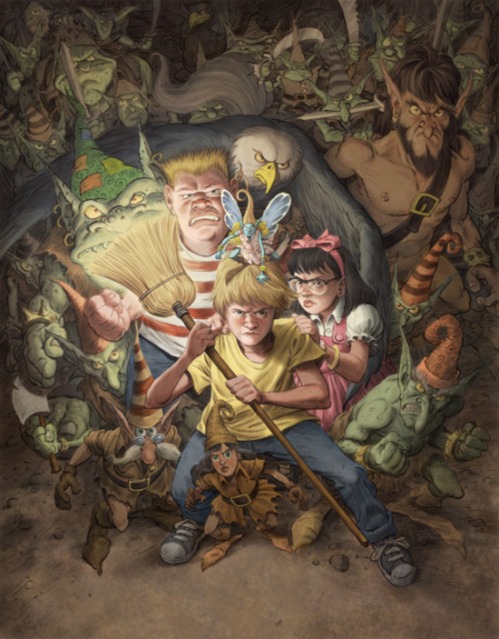
Here’s a detail shot just for the hell of it.
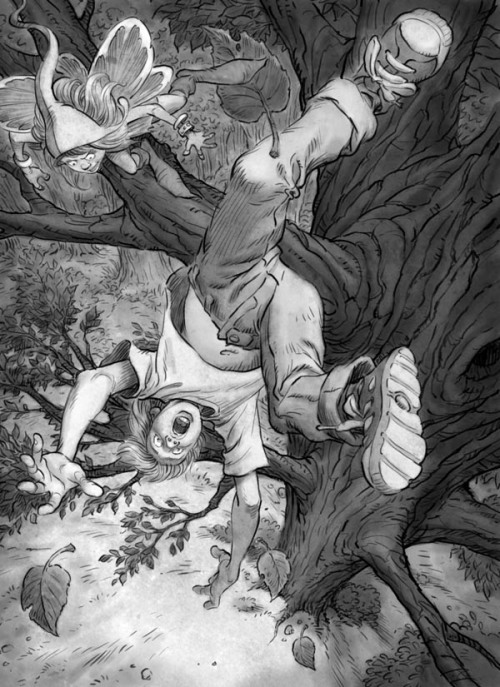
My favorite illustration in this book.
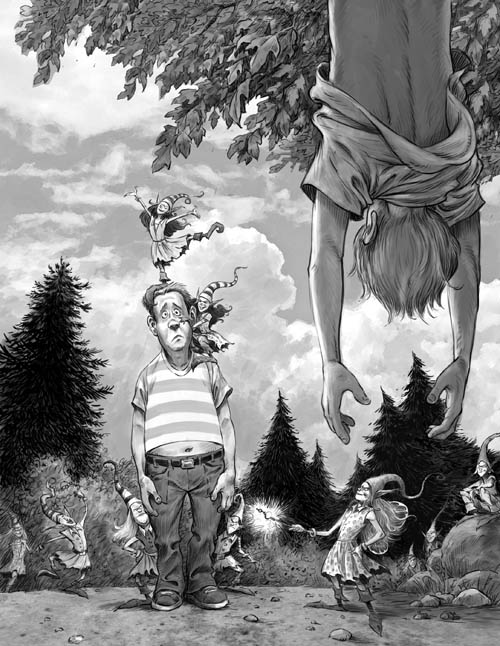
When did you first know that you were good at art and wanted that for your future?
My mom says that she put pens in my crib when I was a baby and I drew cars and cities all over my sheets. so I guess it was decided pretty early on. My early loves were Dr. Seuss and Marvel Comics.
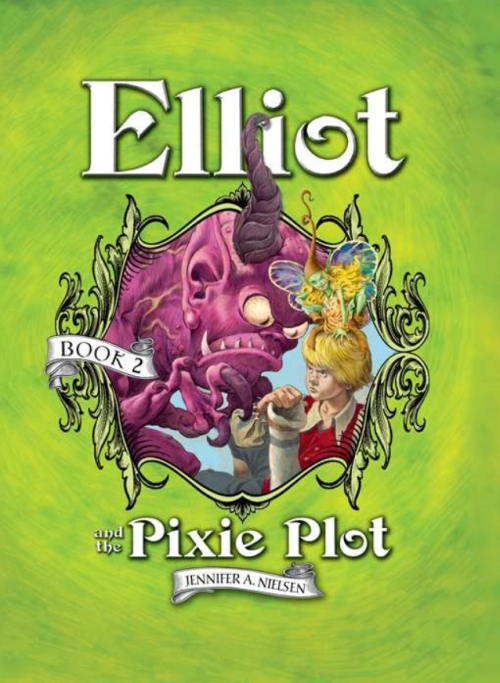
Did you study art at The Cooper Union in New York City?
Yes. I have a BFA from Cooper.
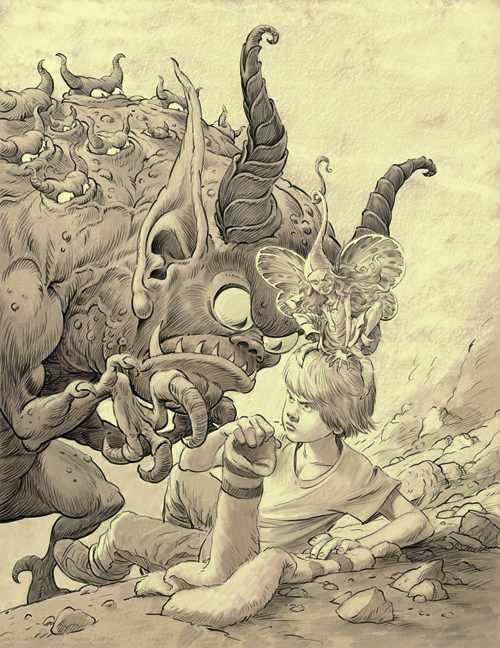
What made you think of putting little Goblins in the big Goblin?
I was just trying to think of how to make him as creepy as possible. It’s an idea similar to themes in some of my “grown up” art.
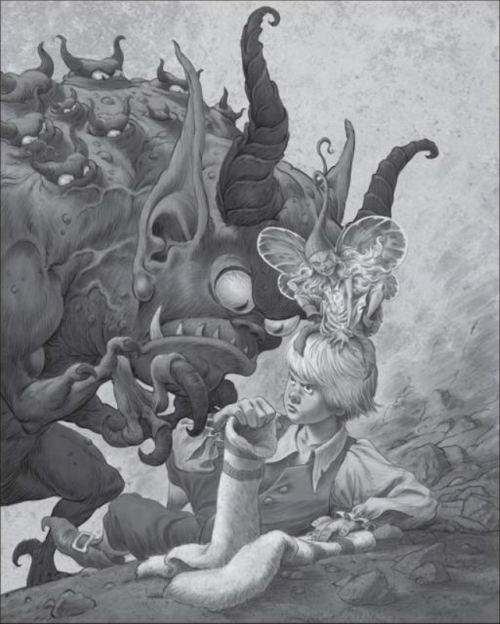
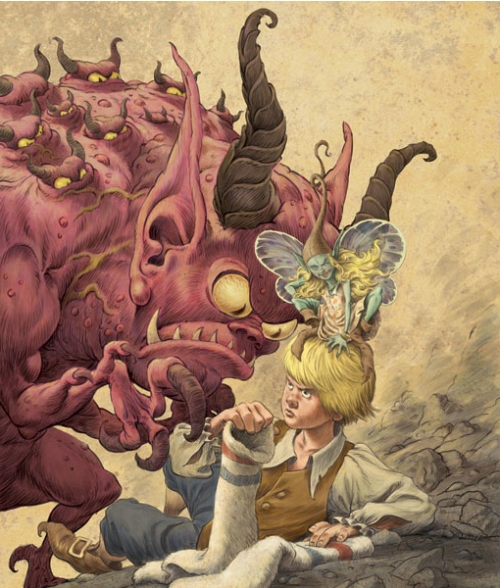
What were you favorite classes?
Painting and drawing. I also enjoyed printmaking, particularly intaglio etching.
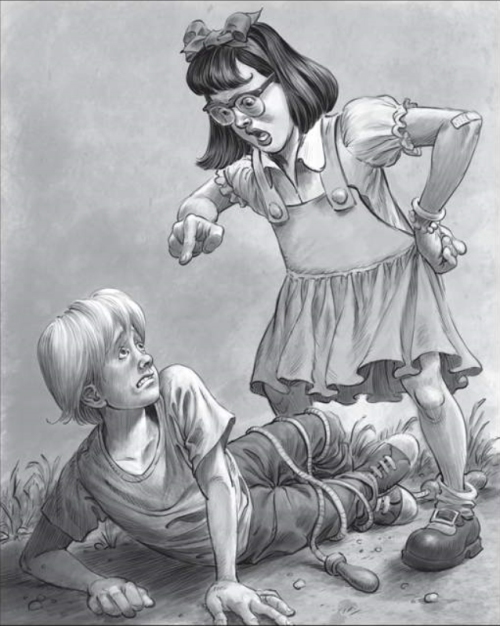
What was the first thing you illustrated and got paid for doing?
I got hired by a local paper in high school to do some courtroom illustration. First and last time I ever did that kind of work. Judging from your next question I think you mean post-collegiate…Hmm. The thing is I went to a strictly “fine art” school. They frowned on illustration, so I had to bury my love of such things.
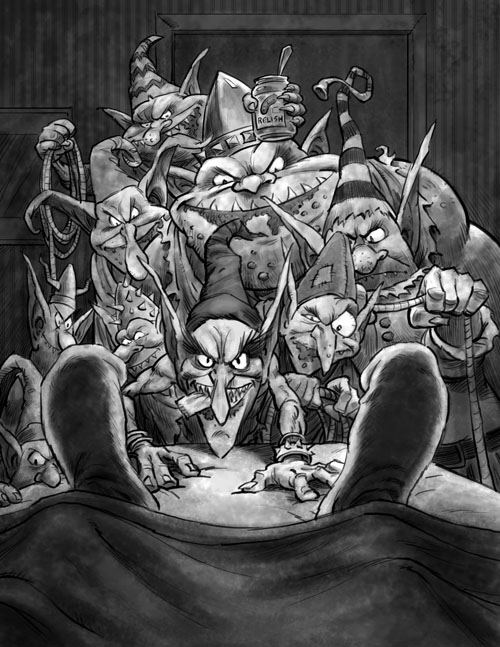
What was your main painting technique back then?
Oils. I did a semester abroad in Italy my junior year and learned the basics of old-fashioned glaze techniques. I’ve loosened up a little since then but my painting technique has always been pretty formal.
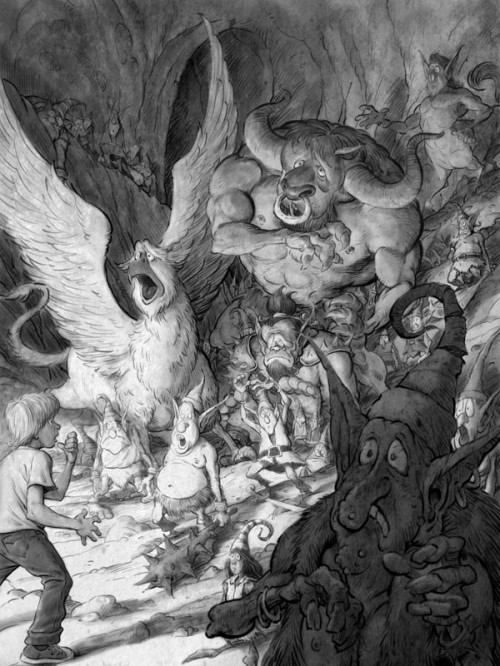
Have the materials you used changed over the years?
Completely. I work almost entirely digitally now. Oil painting is reserved for my personal enjoyment or for the rare occasion when budgets and schedules are generous.
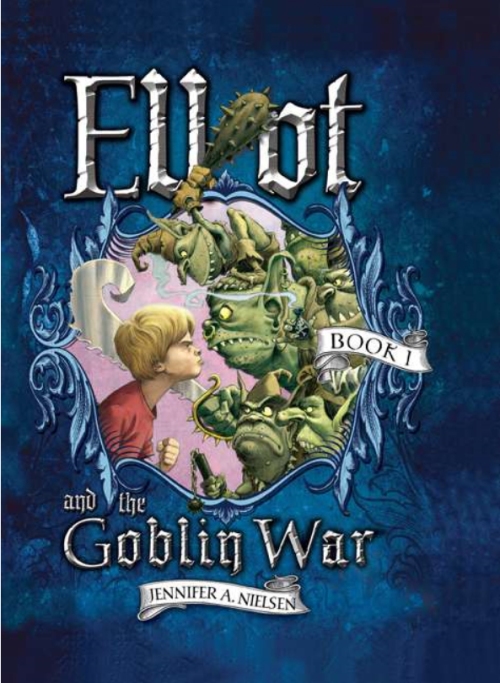
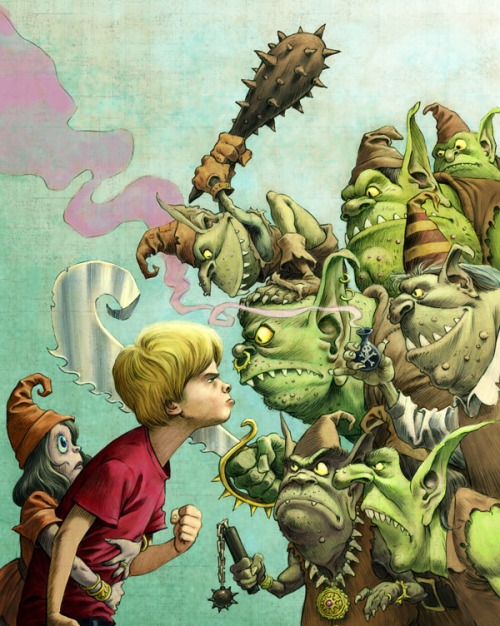
Has the style of your illustration change or evolved into a new style?
I have developed a few distinct styles for the different kinds of work that I enjoy doing. traditional children’s book illustration is at this point only a small part of what I do. among other things I also do black and white chapter book illustrations, puzzle pictures for highlight’s Magazine, maps and diagrams for books, posters, advertisements, etc. I also do “whiteboard” animations as well as graphic novels and comics. Unless you’re hugely successful at one thing, you gotta be a jack of all trades to survive. If one of the things I do really took off I’d be happy to focus more, but in the meantime I do enjoy the challenge.
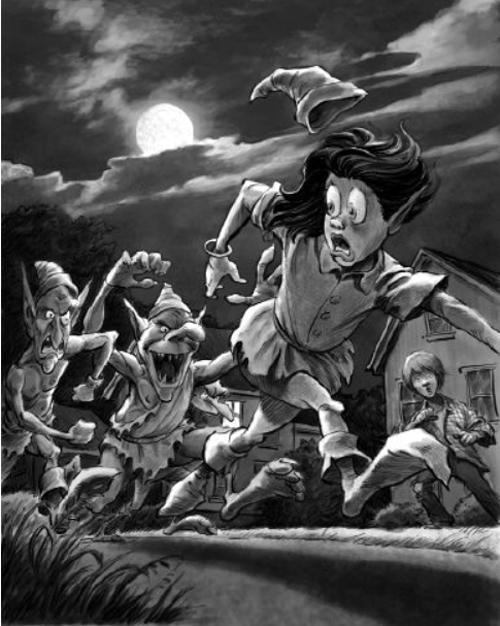
Since you graduated right as the Internet and computers were taking hold. Did you jump into experimenting with digital art at that time?
No, the computer was primarily a word processor and mailing label machine for me for many years. It wasn’t until the late “90′s that I began doing some digital color on my drawings and then the big leap was when I got my first Cintiq in ’06.
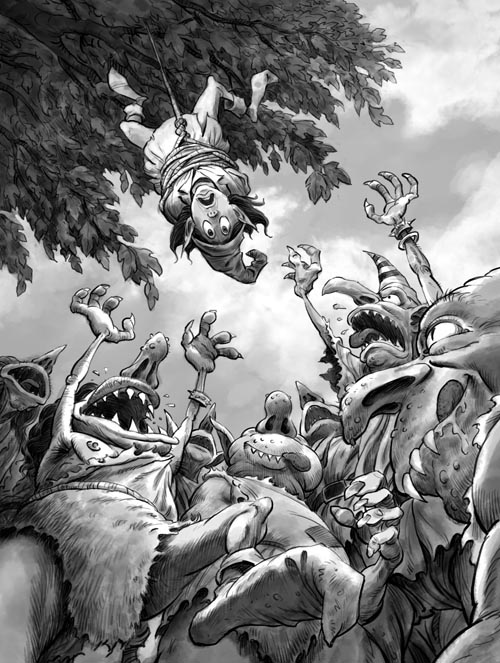
Do you own and use graphic tablet? If so, which one?
A few months ago I got the Cintiq 24HD touch and I’m in love with it.
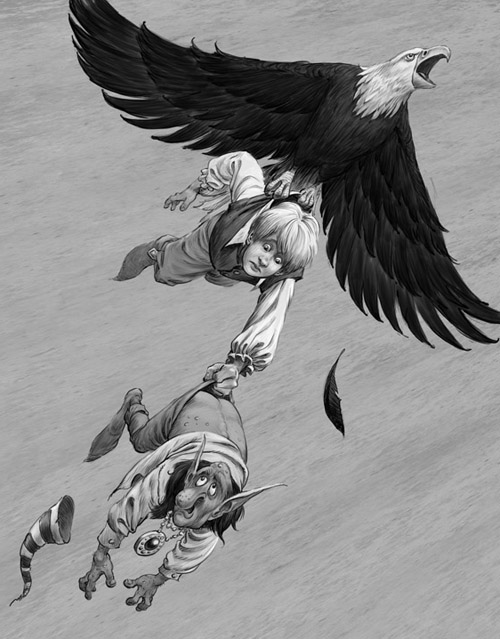
What was your first job after your graduated?
I tried to do the art gallery thing; working as an installer and packer/shipper. It was awful. The people were vain and pretentious and I felt alienated and bored. I got laid off. Freed from the shackles of fine art education/employment, I went back to my early loves: kids books and comics.
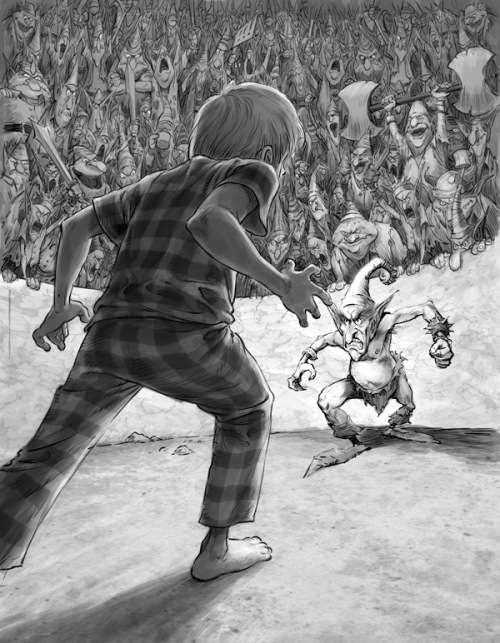
What kind of creature is Elliott going to fight?
Those guys are goblins. The big red/pink creature is the demon Kovol, Elliot’s main nemesis.
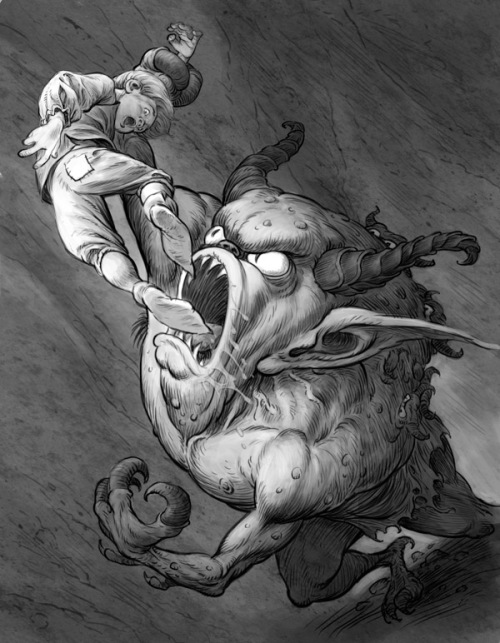
I see you do a lot of black and white illustration. Is that because there is more available work for that?
I wouldn’t say there’s more of it, its just that I’m well-suited for it and I’ve found that I like doing work for older kids (less cutesy stuff, more monsters and weird stuff) and I guess there is more B&W work in that market.
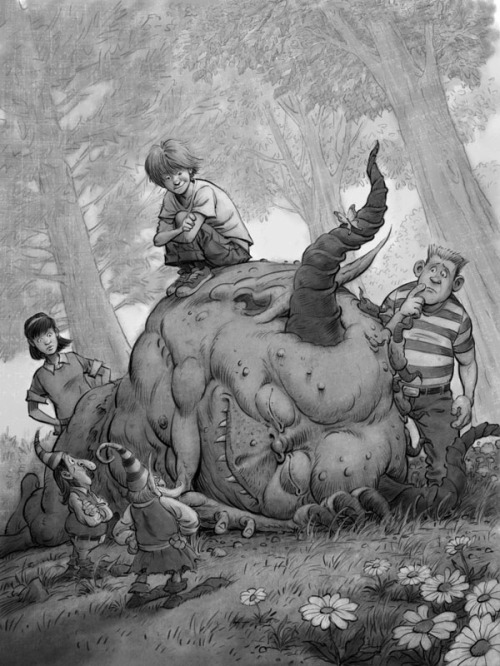
Have most of your comic book art been done for magazines?
No. I haven’t done much comics work for paying clients. I wouldn’t mind it, though. I’m having a great time working on my graphic novel and it would be fun if it led to other opportunities.
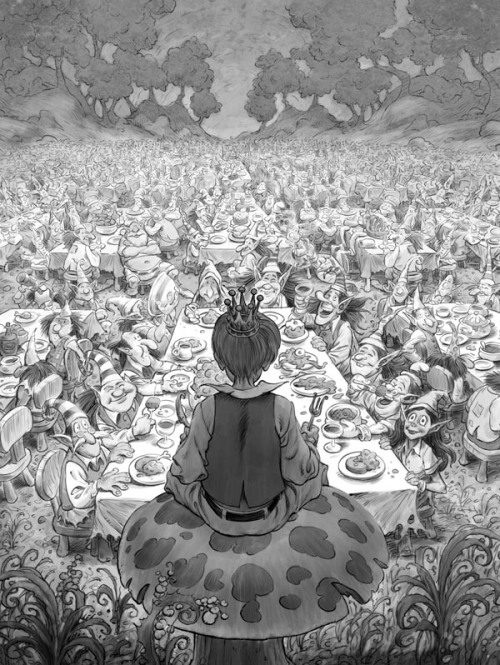
How did you hook up with Ronnie Herman Agency? How long has she represented you?
Way back in the early ’90′s my friend Ian Schoenherr set up a meeting for me with Ronnie when she was an editor at Penguin. At the time my “portfolio” was a mess, consisting of a hodgepodge of different styles, none of them particularly well-executed. Ronnie kept one sample from my portfolio: a painting of a daddy rabbit reading a bedtime story to a baby rabbit. I never got a call from Penguin, but several years later when Ronnie retired from Penguin and started her agency, she remembered that image and called me. She took me on and was very patient with me and helped me develop a cohesive portfolio.
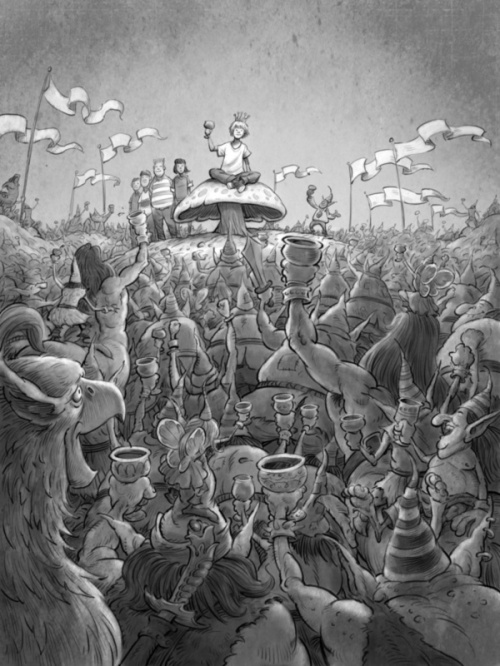
How did you get your first book contract?
Ronnie showed my samples around for a couple years before she got anyone to give me a book project. Eventually Albert Whitman hired me to illustrate Littlebat’s Halloween Story. Not sure what samples got that gig. Interestingly, it was a little painting of a hamster driving a sportscar that got me the Dino Pets gig. That one’s a mystery to me but I’m glad it worked out.
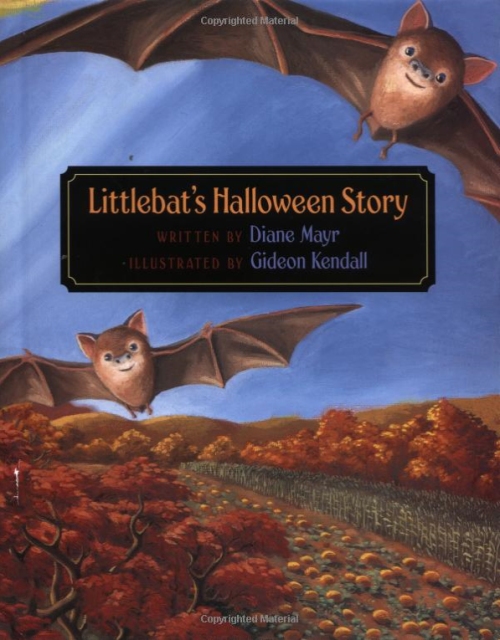
Was Littlebat’s Halloween Story the only picture you have illustrated?
No, I’ve done three. Littlebat, Dino Pets, & Dino Pets Go To School.
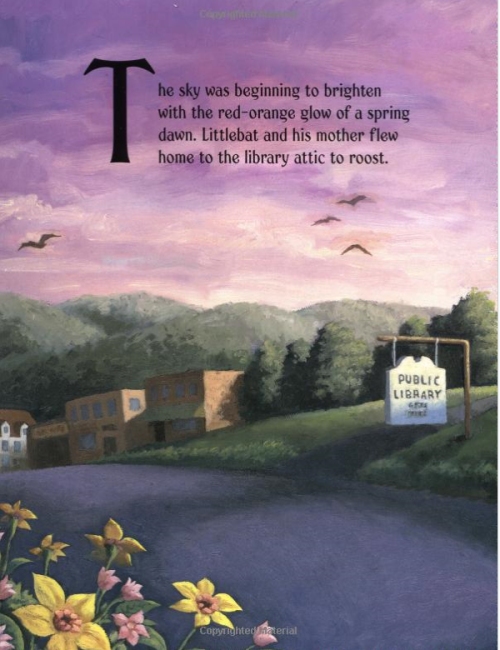
I see you have two books published with Sterling. How did those contracts come about?
Charlie Nix, An old friend from college contacted me about doing the cartoons for those books. He designed the books.
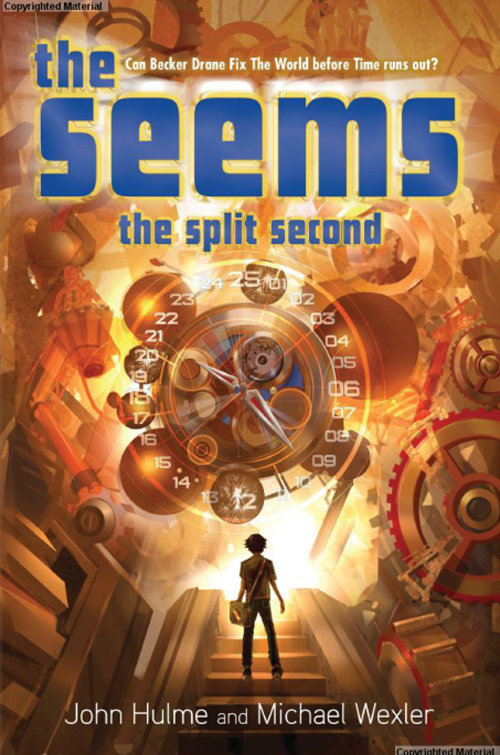
Did you know that it was a two-book deal at the time?
We were pretty sure, but it wasn’t guaranteed.

How did you get to do The Seems series?
Oh boy that’s a long story! Here goes: I was introduced to the authors by a mutual friend who thought we’d make a good creative team. We discussed making a bedtime themed picture book and threw around ideas for a while. We eventually decided on a pillow fort theme and put together a pitch. No one bit on it and I forgot about it but Mike and John didn’t give up and over the next few years they expanded the idea into what eventually became The Seems. Bloomsbury bought it and the authors pushed hard to have me brought in as the artist. They eventually went with someone else for the covers which pissed me off, but I had a great time collaborating with Mike and John and making those pictures. I put a lot into those images. We actually got a movie deal out of it which was a nice windfall but as usual that never went anywhere.
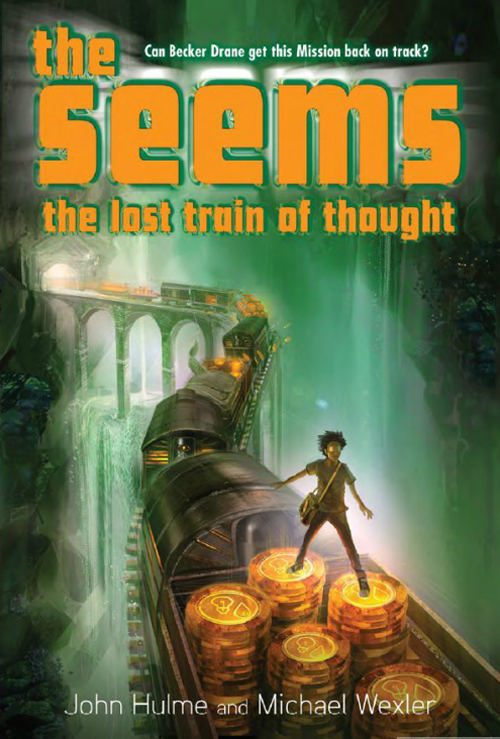
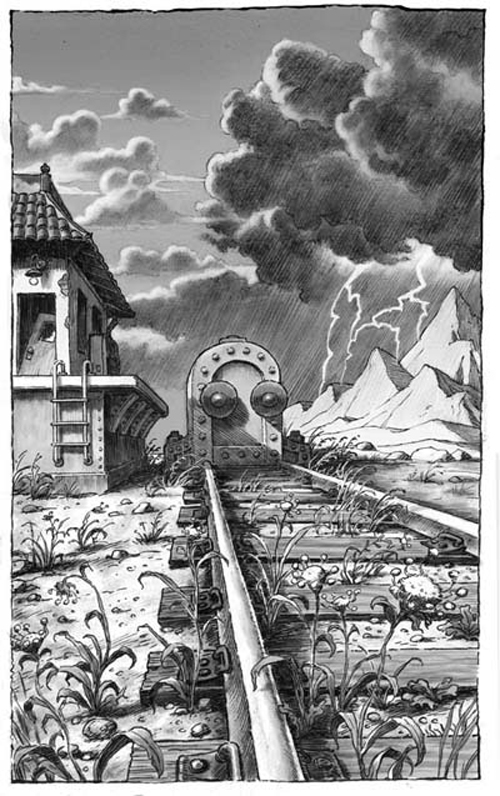 Did you know it was going to be a series when you illustrated the first book?
Did you know it was going to be a series when you illustrated the first book?
The author’s plan was for it to be at least a 3-book series. Of course we all hoped it would go far beyond that….
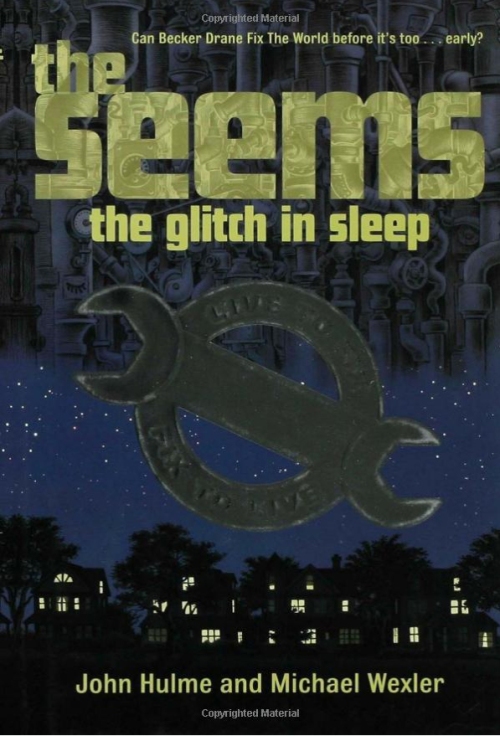

Do you expect there will be more books to that series?
I doubt it. I think it would have had to sell much better for that to happen. The overall concept is certainly deep enough to warrant more stories though.
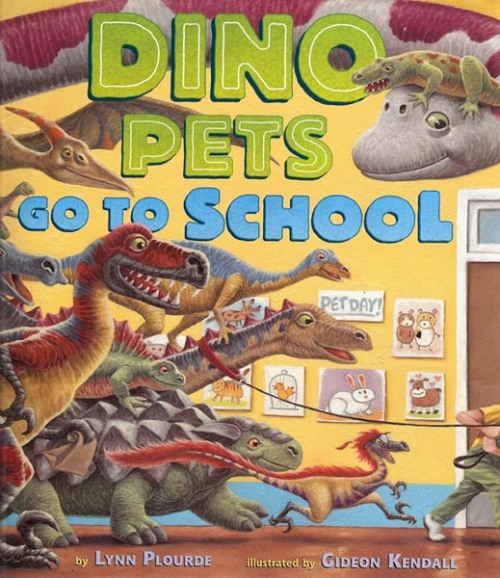
You illustrated four books that came out in 2007. Were you under a lot of pressure to get four books done during that time?
Yeah, but I was happy to have so much work.
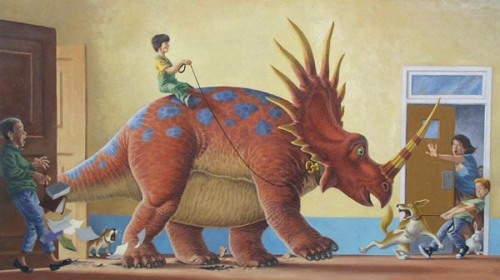
How long do you normally have to work on the illustrations for a book? Shortest? Longest?
There’s no real “normal”. Every job is different. I’d say in general, schedules just get shorter and shorter as everyone expects work to be done digitally.
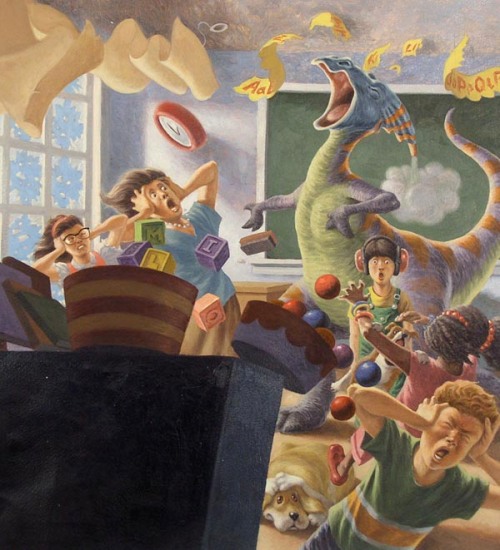
How many black and white illustrations are usually required for a middle grade book?
Anywhere from 8-30. The Elliot books had lots of illustrations, some full page, some spot. Those books were so much fun to illustrate.
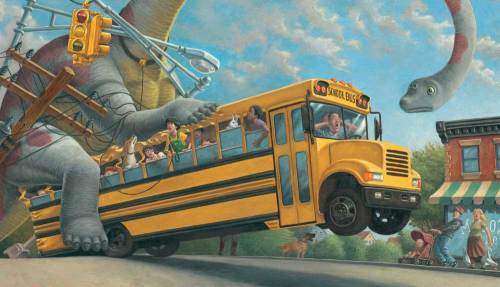
Have worked with any educational publishers?
Yeah, these days that’s where a lot of my work comes from. The money is almost always terrible and of course there are no royalties but its the kind of work you can feel good about doing.
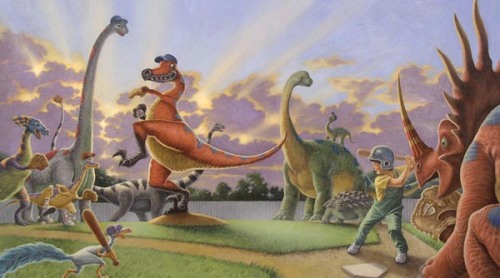
Do you ever see yourself writing one of your own books? Oh yes, believe me! I have numerous unpublished book projects on file, and they’re all awesome, so all you editors and publishers out there, give me or Ronnie a call.
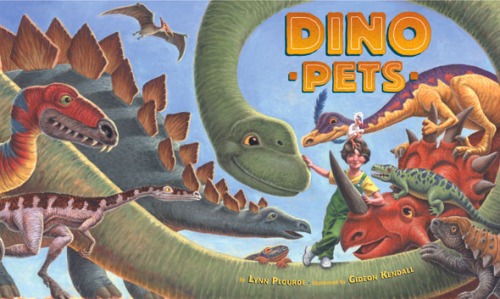
Have you done illustrations for any children’s magazines?
As mentioned, Highlights. They are keeping me very busy these days. I do a monthly hidden picture for one of their magazines and I’m also doing several of the books for their Which Way USA series.
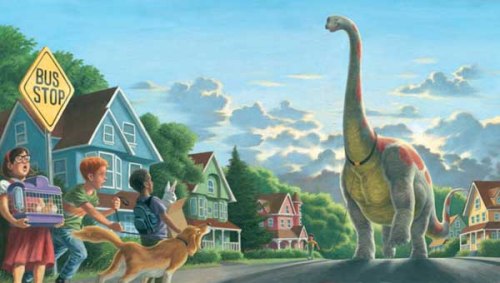
Do you think the Internet has opened doors for you?
Yes. It’s also wasted a lot of my time.
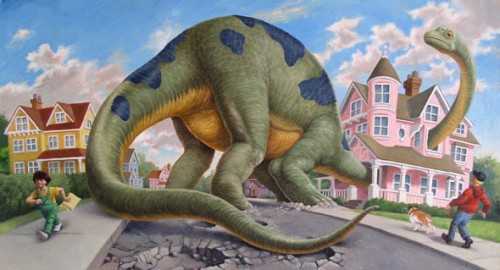
What types of things do you do to find illustration work?
I don’t really seek it out anymore. It comes in through Ronnie or from previous clients or referrals.

What do you feel was your greatest success?
I don’t think I’ve had it yet. I’m proud of the painting in “Dino Pets Go To School” but that book is going out of print I think. I’m also proud of the work I did on the Elliot series and the Seems but neither of those series sold well. Sigh. I’m still waiting I guess.

How did you get involved in TV cartoons, backgrounds, production design, and props.?
In ’94 I was broke and my attempts at being an illustrator were mostly failing. A friend introduced me to J.J. Sedelmier (of Beavis and Butthead & SNL TV Funhouse fame) and he took me on as an intern. I knew nothing about animation but I could draw and paint so I found a role as a background painter (this was pre-digital). I made a short film with Tom Warburton which was seen by some folks at Disney and they hired us to be the designers of a new show for ABC called Pepper Ann. We worked together on that for several years and then Tom created Codename: Kids Next Door for Cartoon Network and I served as his background designer on that show too (a guy named Mo Willems just so happened to be the head writer on the show. Ever heard of him? Even if I never have a hit children’s book I can say that I have played touch football with Mo Willems). After that the bottom fell out of the NYC series animation industry. Most of my colleagues in the industry moved to California. I decided to stay on the east coast and recommit to illustration.
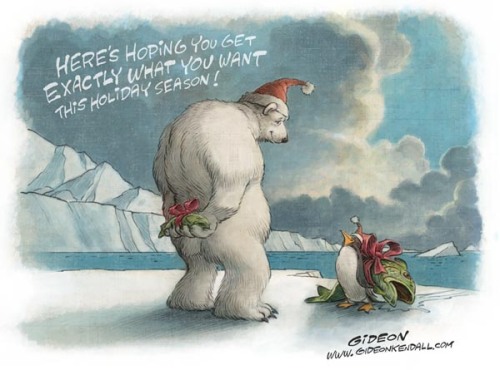
Do you have a studio? What is the one thing in your studio that you could not live without?
I work in the upstairs back room of my house. I’ve got a nice sliding glass door leading out onto a deck with a view of some ugly apartment buildings. I love my Cintiq, and all of my reference books, but the thing I really couldn’t live without is the espresso machine in the kitchen.

Do you try to spend a specific amount of time working on your craft?
Every job is a chance to improve some aspect of my skill set. I just did a story for an educational publisher in which the main character was a 10-year old Asian boy. I took the job mostly because I’m not very good at drawing Asian kids. I just finished the job today and I think I got a little better at it…
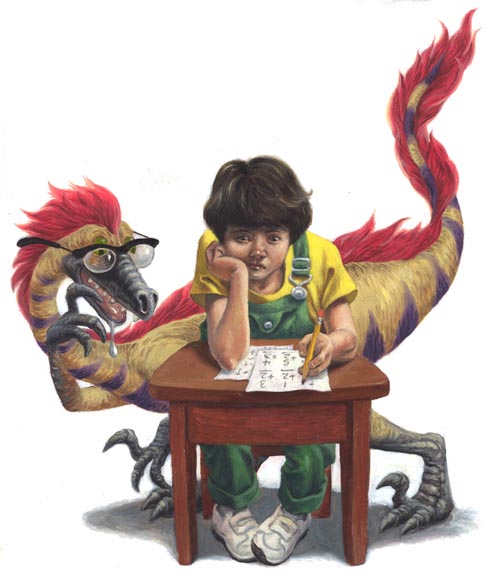
Do you take pictures or do any types of research before you start a project?
I do. I use an OLYMPUS DIGITAL CAMERA.
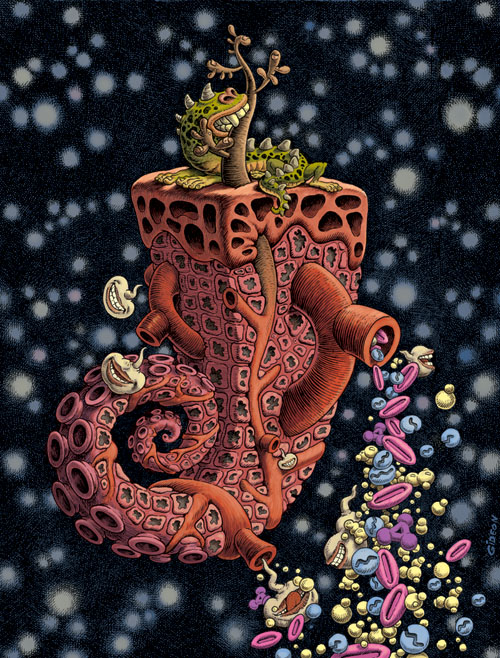
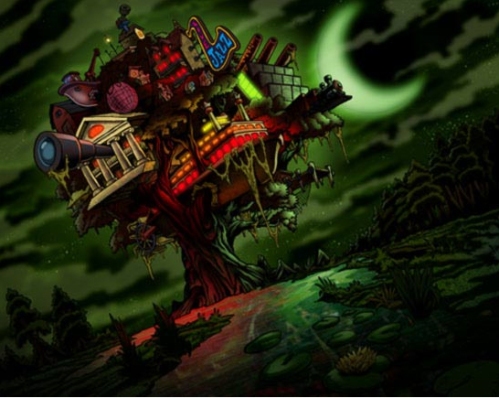
Are you open to doing any illustrations for a writer who wants to self-publish?
If they can pay me and I like the project.

Have you ever thought of self-publishing a book of your own?
Sure. It’s getting easier and more practical to do so. I am self-publishing my graphic novel and selling it and my other comics and prints at various events such as MOCCAfest (happening this weekend in NYC).

Do you use Photoshop or Corel Painter with your illustrations?
I keep meaning to learn Painter at this point I’m strictly a Photoshop guy.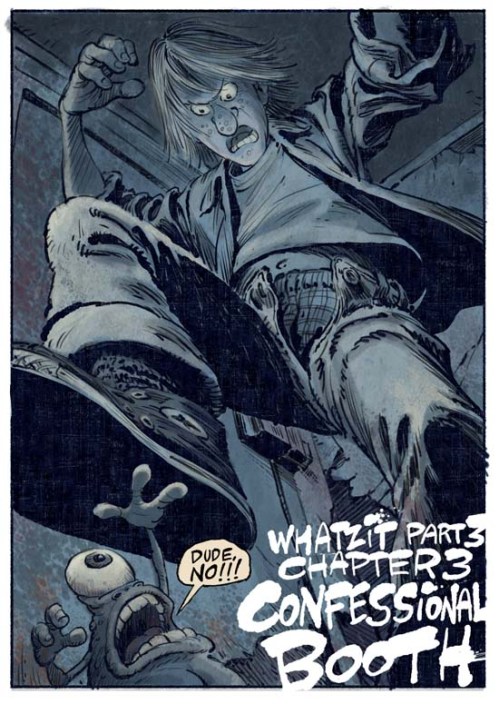
Have you used or plan to use your comic illustrations in a graphic novel?
Yes, I’m working on a graphic novel now. It is definitely not for kids, however. It’s called WHATZIT and you can buy it, along with a lot of my other not-for-kids stuff at http://www.WHATZITCOMIC.COM

It sounds like you are not only a talented illustrator, but an accomplished musician. Could you tell us a little bit about that side of your life, and how you got interested in music?
Acccomplished??? Ha! No, I just love writing songs. I am not particularly skilled as a musician but I enjoy performing and writing, as well as the collaborative nature of music. ITs a nice antidote to sitting alone in my underwear all day drawing pictures.
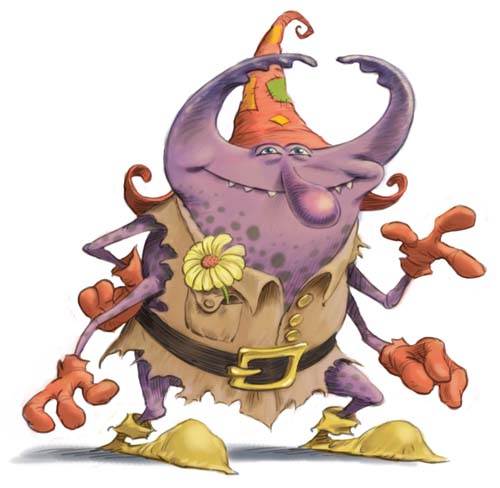
Do you have any career dreams that you want to fulfill?
I want to get some of my own children’s books published.
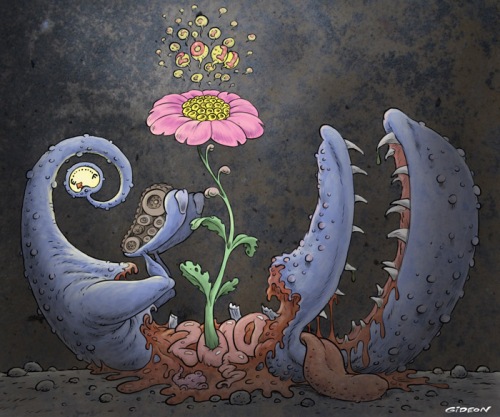
What are you working on now?
Issue #2 of WHATZIT, some whiteboard projects for Idea Rocket, the next issue of Which Way USA for Hightlights, a serious of fine art prints depicting surreal animals and plants in various states of decay, a revision of one my book pitches (it’s called “The Last Story”. Its awesome. Somebody publish it for god’s sake!). I’m busy.
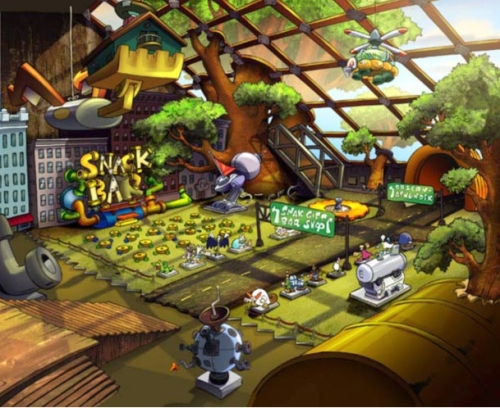
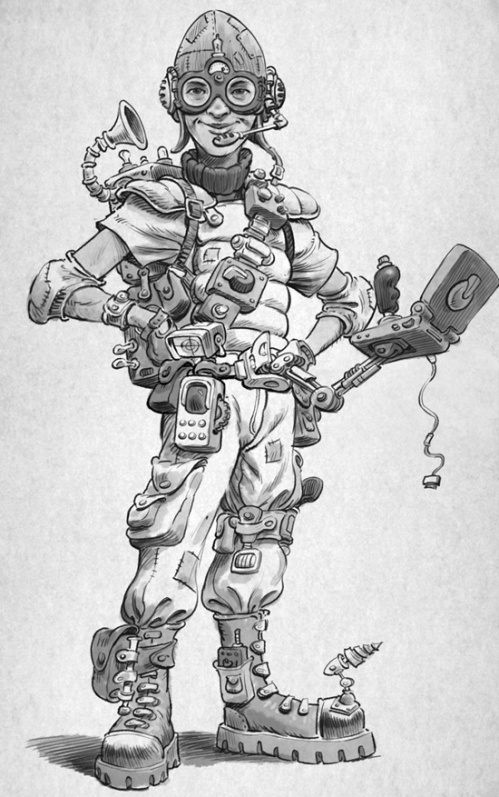
Any words of wisdom on how to become a successful writer or illustrator?
Work your ass of and then get very lucky? I dunno, let me call Mo Willems and get back to you. I do however have some advice on how to function and survive as an unsuccessful illustrator: Love your work. Never be satisfied. Get some exercise. Punk rock and espresso are great for tight deadlines.
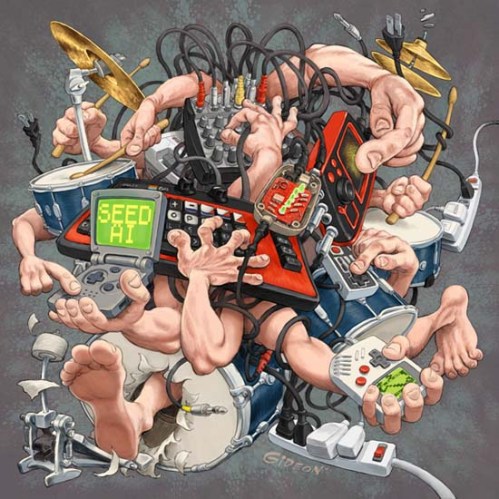
Gideon thank you for sharing your wonderful illustrations, process, journey, and expertise with us. Please keep in touch and let us know of all your future successes. We would love to hear about them.
You can visit Gideon at his Illustration website: http://www.gideonkendall.com
Graphic Novel Website: WHATZIT : http://activatecomix.com/152.comic
Please take a minute and leave Gideon a comment. It is always appreciated. Thanks!
Talk tomorrow,
Kathy
Filed under:
authors and illustrators,
demystify,
How to,
Illustrator's Saturday,
inspiration,
Interview,
picture books,
Process Tagged:
Cartoon Network,
Gideon Kendall 

.png.jpg?picon=4257)
By: Diana Hurwitz,
on 4/4/2014
Blog:
Game On! Creating Character Conflict
(
Login to Add to MyJacketFlap)
JacketFlap tags:
fiction,
writing,
character,
plot,
communication,
craft,
reactions,
action,
emotion,
movement,
how to,
expressions,
body language,
Add a tag
Gestures are not random. They have purpose. They illustrate. They convey the words we do not speak. They confirm, deny, or emphasize what we say. People "talk with their hands."
Gestures vary from person to person and culture to culture. People can have nervous ticks. They can have "tells" that indicate they are lying, anxious, or unhappy. Use gestures wisely.
If a gesture begins before the words, it is a sign of honesty.
If a gesture lags after the words, it's considered a sign of dishonesty.
A gesture can be involuntary but squelched by the character. This is especially true if he is angry with someone he cares about or fears.
Gestures include:
air kisses
averted gaze
bared teeth
biting cuticles, hair, lips, or nails
blowing raspberries
bowing
chewing inside of lips or cheek
crossing ankles
crossing/uncrossing arms
crossing/uncrossing legs
curtsey
cuticle picking
elbow bump
eye rolling (or eye-ball rotating)
eyebrows lift
eyebrows wrinkle
finger curling
finger pointing
fist shaking
fist swinging
flapping hands
flicking fingernails
fingernail tapping
genuflecting
grasping elbows
gripping hands
hands behind back
hands over face
hands over heart
hands together
hands wide
hat tip
index finger raised
kowtow
lip curls or purses
looking down
looking up
looking to the side
lowering arms
lowering hands
middle finger raised
mooning
mouth purses
mouth tightens
nodding
nose thumbing
nose wrinkles
pointing
pouting
raising arms in the air
rubbing earlobe
rubbing fingers
rubbing hands
scratching
scratching chin, ear, nose, or throat
shaking head
shrugging
sneering
sticking out tongue
swinging legs
slash throat with hand
smoothing hair
tapping fingers or toes
tucking legs under
thumbs up
thumbs down
thumb to the side
tightening fist
tugging clothes
tugging an ear
tugging hair
saluting
sweeping hands
waving
Keep this list handy and add to it.
When revising, cut repetition and make sure the gesture is used for a good reason at the right time.

By:
Robin Brande,
on 4/1/2014
Blog:
Robin Brande
(
Login to Add to MyJacketFlap)
JacketFlap tags:
Pets,
Dogs,
Animals,
How To,
Dog Training,
Porcupines,
Animal Training,
Baby Danger,
Dog Advice,
Dog Training Advice,
Dogs and Porcupines,
Dogs and Wildlife,
Pet Advice,
Add a tag
Once again, crisis and injury averted thanks to a clever dog training technique I learned from master trainer April Bush.
A little background: Last fall while we were backpacking in the San Juan range of the Rocky Mountains, I heard some commotion one morning coming from the area where husband and dogs had gone off to retrieve our food bags from where we hung them in the trees overnight to keep them away from the bears.
Our younger Lab, Baby Moose, aka Baby Danger, was only about 10 months old. He’d already earned his nickname when he was 5 months old and jumped from a moving car just because that seemed interesting. He rolled several times, just a ball of whirling black fluff, while I watched in horror before catapulting out of the car myself, but by the time I reached him he’d already stood up and shaken it off like it was no big deal. “What are you looking at, Mom?”
Baby Danger.
So now fast-forward several months and I’m hearing his unusually deep, serious bark coming from that area where bear bags are hung. Then I hear my husband shout, “Moose!” and then even more loudly, “Robin!” And that’s never good, because it usually means there’s some sort of emergency calling for my wilderness medical skills.
Great.
So I start fumbling into my boots, but before I can get them on I hear my husband tell Moose very calmly, “Go show your mom.”
And here comes trotting toward me, very proud, Baby Danger with a face full of porcupine quills. Twelve of them. While our older dog had the sense to keep his distance from the porcupine they both found, Moose went right for it. Why not? Looks interesting. He didn’t even seem bothered by all the needles stuck in his snout–at least not until I started prying them out one at a time with the plier setting of the multi-tool I was happy we brought along.
So now here we are, six months later, and you’d think the dog had a sense of history or self-preservation or just some sense in general. Nope.

Baby Danger
Yesterday while he and I were cross-country skiing in some beautiful woodlands, he suddenly veered off toward a tree. I kept skiing, not thinking anything of it, until I once again heard that deep, manly bark of his that only seems to come out when he’s found something particularly dangerous and worth chasing.
I quickly reversed course.
Moose stood at the base of a tree, barking his lungs out at a huge beach ball-sized porcupine perched on a low branch only about a foot above him. Well within quilling distance. The porcupine kept puffing himself larger and doing this cool trick where the spikes rolled in a wave across his back as if someone were running a hand over a fresh buzz cut. It was impressive, but also kind of awful. Because any second those quills were going to start shooting into my dog’s face.
I shouted, “Moose, leave it!” and “Come!” but as you can imagine, boring commands like that were nothing compared to the thrill of a treed beast.
But I had one more command in my arsenal. The magic one I’d learned from April.
“COOKIEEEEEEEEEEEEEEEEE!!!!!”
Moose tore himself away from the porcupine and came racing toward me. Unbelievable. I opened up my treat bag and let the heavens rain treat. Because that’s what the special word “Cookie” has come to mean. It has to mean that every time.
Here’s what April taught me: Come up with some special word that you only use in the most dire circumstances when you really, really need your dog to come to you. Maybe it’s because he’s about to run out into traffic, or he’s chasing something he shouldn’t, or he’s a black dog who’s run off into the darkness at night and you have no hope of finding him otherwise.
“Cookie” is a good word to use because you can really draw out the sound. Anything ending in an “ee” sound is great.
To build the power of the special word, you start using it a few times a day at unexpected, random times. You’ll always want to have a good supply of your best treats on hand–the thing that makes this word so special is that the dog really hits the jackpot of treats once he responds.
The first time, stand close enough that your dog can see you. Then call out the word with as much enthusiasm and volume as you can. The dog won’t quite understand what you’re doing this first time, so open your hand and show the monster mound of treats. Yes, lad, you get every one of these if you come.
Do it again some time later that first day, standing just out of sight of your dog. See if he remembers what happened last time. He probably will. Again, huge jackpot of great treats, one after another for about 30 full seconds. You want this to be the most fabulously-rewarded command in your entire arsenal.
And a key part of the training is that it has to be a totally positive experience. You can’t use “Cookie” and then leash up the dog or put him in his crate or do anything he might not have come running for if he’d known. In a crisis situation you are going to hold on to him and probably leash him up, but he doesn’t need to know that right now.
Do it about 3 times a day for a week. Then just once a day for the following week. Then every other day, gradually tapering off until you do it once a week. The whole process should take only a few weeks, but it’s worth continuing to strengthen it weekly.
Because there will come a time, just like my experience yesterday, when you’re going to want your dog to remember how fantastic it is to drop everything and run for the Cookieeeeee! I cannot tell you how happy and relieved I was that it worked.

Me sportin’ the ever-trendy treat pouch.
The down side, from a fashion standpoint, is that you’re going to end up wearing something like this hot-looking number whenever you go somewhere where you’ll have your dogs off-leash. I know, I know, you’re insanely jealous right now. I understand.
The alternative is to carry a bunch of great, smelly treats in your pocket, and maybe end up like Elaine in that Seinfeld episode where she’s running from a pack of dogs because she’s hidden mutton in the pockets of her coat. Don’t ask why. Just watch the episode.
So that’s my how-to for the day. If you have a dog like mine with a will of his own, you’re going to need some magic every now and then to keep him out of danger. I don’t know if this will work on Moose every time, but I’m grateful it worked yesterday.
Peace out!

By: Kathy Temean,
on 3/31/2014
Blog:
Writing and Illustrating
(
Login to Add to MyJacketFlap)
JacketFlap tags:
Agent,
Tips,
list,
Advice,
article,
illustrating,
authors and illustrators,
How to,
Directory of Illustration,
Freelance Pricing,
Friend + Johnson,
Joann Miller,
Add a tag


You may know Joann Miller over at the Directory of Illustration. Well, she asked Friend + Johnson (illustration representation agency) if she could share the best advice they had about pricing that they would give an illustrator. I thought I would share the part about how to come up with a price for a potential client. It is quite good.
Here is a list of questions to ask your potential client to help create an accurate estimate that fulfills both their expectations and your needs.
Introduction
1. How did you find out about me? Is there something in your portfolio that inspired them to think of you for this project? Make sure you understand exactly what they’re referencing so you can make sure you’re comfortable executing it, and are clear on what they’re hiring you to do. This will also help you determine the level of complexity of the illustration they’re looking for.
Project Description
2. Do you have a layout? How complex are the illustrations? Are they single-spot illustrations or more complex scenarios? Are they providing any references for you to use? Are they looking for you to concept illustration ideas with the creatives, or are you working from a pre-approved layout that will not allow for much change? Is this black-and-white or a four-color piece? Are you working in layers?
3. What is the timing for the initial pencils and the final illustration? Usually, you should have three to four days for the initial pencils, and after client approval, another five to seven days to deliver the final. Two rounds of pencils are standard; anything more should have an additional charge.
Usage, Licensing and Copyright
4. Usage is very important in helping you price your project. Note that consumer advertising will be priced much higher than illustrations for a children’s book or direct mail.
Does the client want national, regional, international, web or worldwide uses? How long is the usage? What is the media use: consumer ad, trade ad, packaging, direct mail, billboards, brochures?
5. If clients say they want unlimited use, you should explore if this is really what they need and offer alternative licensing to match their budget. Often times, clients are not “educated” in this area of rights-based pricing; they will be much more understanding if you take the time to outline that they will ultimately save money by purchasing just the usage they need. For example, if they see the difference in cost for a two-, three- or five-year use, this may be more in-line with what they really need vs. unlimited use/time.
Most clients aren’t planning on a consumer magazine campaign or any out of home use, they may just want unlimited collateral (direct mail and consumer or trade brochures and inserts) use. Find out specifically what they’ll use the artwork for and tailor your pricing to match.
6. If at all possible, never do “work for hire,” give buyouts or sell your copyright. You’re essentially giving away all of your rights as the creator of the artwork and giving ownership to your client. They in turn can reuse and resell the artwork in any way they want.
You can still retain your copyright even if it’s unlimited use, worldwide for an unlimited time and exclusive to them. If they feel they may need the artwork for other uses down the road or for a longer period of time, these extended uses can be renegotiated or factored into the original contract as well.
Remember, they want to use you and you want to work with them. This is a negotiation to give them what they need and pay you fairly for the creation and use of the work. You’re working together to create a fair contract for both parties.
7. Will this image have resale potential in stock or other markets? Does your licensing give you this option?
Keep Budgets & Other Paperwork in Mind
8. Editorial and book clients usually have a predetermined budget. Sometimes you can renegotiate if you feel it’s too low for the amount of work they’re requesting. You should always get a credit line for editorial or pro-bono work.
9. Do they have an allotted budget already in mind? If not, when do they need numbers?
10. Is there a contract? You should have your own contract in addition to anything they supply.
Hang Up
11. Never give an estimate while you’re on the phone with your client. It’s best to hang up and think about what you’re comfortable with.
12. Review your estimate before submitting it. A great source for guidelines for estimating various projects is the “Graphic Artists Guild Handbook” at www.graphicartistsguild.org/handbook/.
Post-Submittal
13. After you have submitted your estimate and it’s approved, make sure to have it signed and sent back to you.
14. After the project is confirmed, you should bill 50% of the job. This is important for cash flow since illustration projects can stretch over a number of weeks with the back-and-forth for approvals. This is also important with a new client that you don’t have a payment history with.
15. In addition to billing upon confirmation AND having a new client sign your contract, you may want to get a purchase order from you client as it is a contract to purchase your services from your buyer.
To read all the other helpful information use this link: http://joannsartadvice.blogspot.com/2014/03/take-charge-of-pricing-your.html
Talk tomorrow,
Kathy
Filed under:
Advice,
Agent,
article,
authors and illustrators,
How to,
illustrating,
list,
Tips Tagged:
Directory of Illustration,
Freelance Pricing,
Friend + Johnson,
Joann Miller 


By: Kathy Temean,
on 3/30/2014
Blog:
Writing and Illustrating
(
Login to Add to MyJacketFlap)
JacketFlap tags:
How to,
Jerry Seinfeld,
Acheive Your Goals,
Secret of Productivity,
Stop Procrastinating,
The Seinfeld Strategy,
Tips,
writing,
Advice,
article,
Add a tag
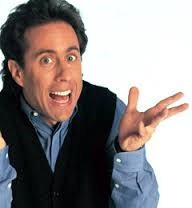 What’s most impressive about Seinfeld’s career isn’t the awards, the earnings, or the special moments — it’s the remarkable consistency of it all. Show after show, year after year, he performs, creates, and entertains at an incredibly high standard. Jerry Seinfeld produces with a level of consistency that most of us wish we could bring to our daily work.
What’s most impressive about Seinfeld’s career isn’t the awards, the earnings, or the special moments — it’s the remarkable consistency of it all. Show after show, year after year, he performs, creates, and entertains at an incredibly high standard. Jerry Seinfeld produces with a level of consistency that most of us wish we could bring to our daily work.
Compare his results to where you and I often find ourselves. We want to create, but struggle to do so. We want to exercise, but fail to find motivation. Wanting to achieve our goals, but — for some reason or another — we still procrastinate on them.
What’s the difference? What strategies does Jerry Seinfeld use to beat procrastination and consistently produce quality work? What does he do each day that most people don’t?
I’m not sure about all of his strategies, but I recently discovered a story that revealed one of the secrets behind Seinfeld’s incredible productivity, performance, and consistency.
Let’s talk about that what he does and how you can use the “Seinfeld Strategy” to eliminate procrastination and actually achieve your goals.
The Seinfeld Strategy
Brad Isaac was a young comedian starting out on the comedy circuit. One fateful night, he found himself in a club where Jerry Seinfeld was performing. In an interview on Lifehacker.com, Isaac shared what happened when he caught Seinfeld backstage and asked if he had “any tips for a young comic.”
Here’s how Isaac described the interaction with Seinfeld:
“He said the way to be a better comic was to create better jokes and the way to create better jokes was to write every day.
“He told me to get a big wall calendar that has a whole year on one page and hang it on a prominent wall. The next step was to get a big red magic marker. He said for each day that I do my task of writing, I get to put a big red ‘X’ over that day.
” ‘After a few days you’ll have a chain. Just keep at it and the chain will grow longer every day. You’ll like seeing that chain, especially when you get a few weeks under your belt. Your only job is to not break the chain.’ “
You’ll notice that Seinfeld didn’t say a single thing about results.
It didn’t matter if he was motivated or not. It didn’t matter if he was writing great jokes or not. It didn’t matter if what he was working on would ever make it into a show. All that mattered was “not breaking the chain.”
And that’s one of the simple secrets behind Seinfeld’s remarkable productivity and consistency. For years, the comedian simply focused on “not breaking the chain.”
Let’s talk about how you can use the Seinfeld Strategy in your life.
How to stop procrastinating
Top performers in every field — athletes, musicians, CEOs, artists — are all more consistent than their peers. They show up and deliver day after day, while everyone else gets bogged down with the urgencies of daily life and fights a constant battle between procrastination and motivation.
While most people get demotivated and off-track after a bad performance, a bad workout or simply a bad day at work, top performers settle right back into their pattern the next day.
The Seinfeld Strategy works because it helps to take the focus off of each individual performance and puts the emphasis on the process instead. It’s not about how you feel, how inspired you are or how brilliant your work is that day. Instead, it’s just about “not breaking the chain.”
All you have to do to apply this strategy to your own life is pick up a calendar and start your chain.
A word of warning
There is one caveat with the Seinfeld Strategy. You need to pick a task that is meaningful enough to make a difference, but simple enough that you can get it done.
It would be wonderful if you could write 10 pages a day for your book, but that’s not a sustainable chain to build. Similarly, it sounds great in theory to be able to deadlift like a maniac every day, but in practice you’ll probably be over-trained and burned out.
So step one is to choose a task that is simple enough to be sustainable. At the same time, you have to make sure that your actions are meaningful enough to matter.
For example, researching good jokes each day is simple, but you’re never going to write a joke by merely researching. That’s why the process of writing is a better choice. Writing can actually produce a meaningful result, even when it’s done in small doses.
Similarly, doing 10 pushups per day could be simple and meaningful depending on your level of fitness. It will actually make you stronger. Meanwhile, reading a fitness book each day is simple, but it won’t actually get you in better shape.
Choose tasks that are simple to maintain and capable of producing the outcome you want.
Another way of saying this is to focus on actions and not motions.
Mastery follows consistency
The central question that ties our community together — and what I try to write about every Monday and Thursday — is “how do you live a healthy life?” This includes not merely nutrition and exercise, but also exploration and adventure, art and creativity, connection and community.
But no matter what topics we’re talking about, they all require consistency. No matter what your definition is of a “healthy life,” you’ll have to battle procrastination to make it a reality. Hopefully, the Seinfeld Strategy helps to put that battle in perspective.
Don’t break the chain on your workouts, and you’ll find that you get fit rather quickly.
Don’t break the chain in your business, and you’ll find that results come much faster.
Don’t break the chain in your artistic pursuits, and you’ll find that you will produce creative work on a regular basis.
So often, we assume that excellence requires a monumental effort and that our lofty goals demand incredible doses of willpower and motivation. But really, all we need is dedication to small, manageable tasks. Mastery follows consistency.
Written by James Clear at Entrepreneur.com
Take tomorrow,
Kathy
Filed under:
Advice,
article,
How to,
Tips,
writing Tagged:
Acheive Your Goals,
Jerry Seinfeld,
Secret of Productivity,
Stop Procrastinating,
The Seinfeld Strategy 


By: Kathy Temean,
on 3/28/2014
Blog:
Writing and Illustrating
(
Login to Add to MyJacketFlap)
JacketFlap tags:
Interview,
Tips,
inspiration,
Process,
illustrating,
Templar Publishing,
How to,
Illustrator's Saturday,
Lyn Stone,
Armadillo Childrens books.,
Add a tag
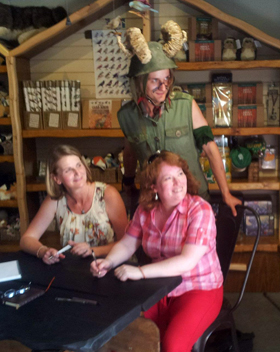 Lyn Stone has worked in a variety of jobs, including a Curator at the Tower of London. Being rather small she was the only member of staff who could climb into the display cabinets to clean Henry VIII’s Codpiece, whilst Japanese tourists happily took photographs! She can also boast accidentally shocking an Amerian tourist who mistook two flintlock dueling pistols for gun with real amo! She has also worked as a freelance model-maker for television, working on a variety of shows, for the BBC and ITV. As a model-maker she found herself working with puppets, actors as well TV crew. On one memorable occasion Lyn made a model so big, it had to be built in her garage. Much to the amusement of all her neighbours when a large lorry, bearing the slogan ‘British Broadcasting Corporation’ turned up to collect it and struggled up a very narrow lane!
Lyn Stone has worked in a variety of jobs, including a Curator at the Tower of London. Being rather small she was the only member of staff who could climb into the display cabinets to clean Henry VIII’s Codpiece, whilst Japanese tourists happily took photographs! She can also boast accidentally shocking an Amerian tourist who mistook two flintlock dueling pistols for gun with real amo! She has also worked as a freelance model-maker for television, working on a variety of shows, for the BBC and ITV. As a model-maker she found herself working with puppets, actors as well TV crew. On one memorable occasion Lyn made a model so big, it had to be built in her garage. Much to the amusement of all her neighbours when a large lorry, bearing the slogan ‘British Broadcasting Corporation’ turned up to collect it and struggled up a very narrow lane!
Her main line of work, however, has been that of an artist and illustrator. Her amusing drawings have enlivened the pages of many children’s books, from history books to children’s play scripts, and pop-up books. Some of her regular clients have included Oxford University Press, Templar Publishing and Armadillo Childrens books.
She has lived all her life in south-east London, and when not at her lightbox she enjoys forays from the suburbs to the bright lights, theatres and cinemas of the West End. However soon she’ll be packing her bags and moving to the seaside in Kent, and is hoping that the Kent countryside and beaches will inspire her work!
Here is Lyn showing and discussing her process:
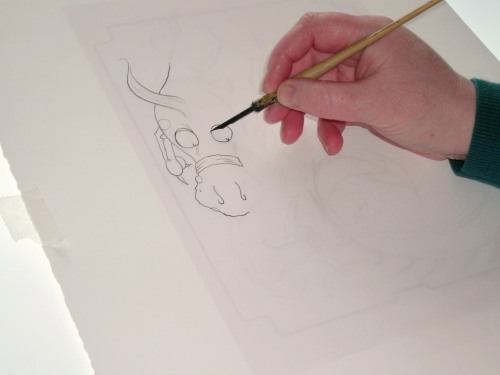
Step 1 – I place the sketch or enlarged thumbnail onto a lightbox. The watercolour paper is placed on top and using an acrylic-based ink I begin inking the drawing, without following the sketch too carefully.
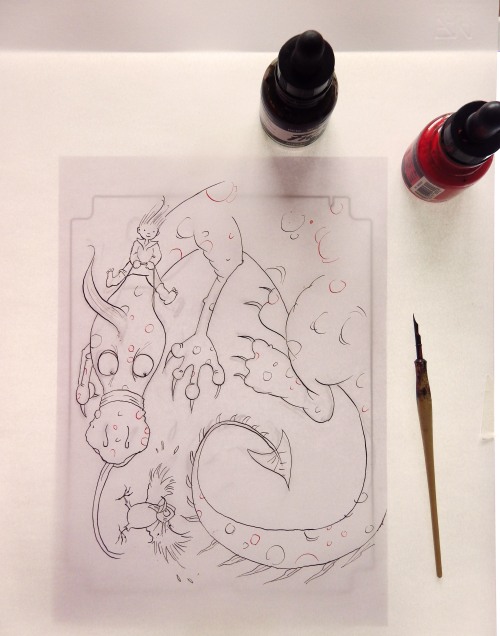
Step 2 – Here is the finished inked artwork. I then stretch the paper using traditional methods.
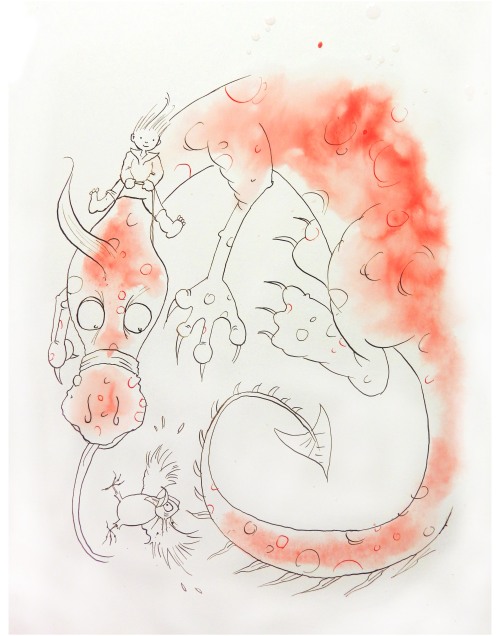
Step 3 – Once dry. I flood the paper with clear water and begin adding the first colour, which spreads and pools in the water in nice unpredictable ways. Start building the colours up a little. Again I am using the wet-in-wet technique.
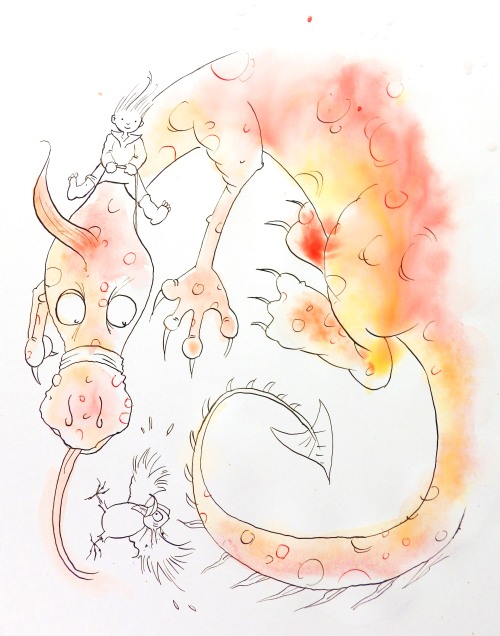
Step 4 – While everything is still very wet, I like to ‘push’ the colours around a little so they merge.
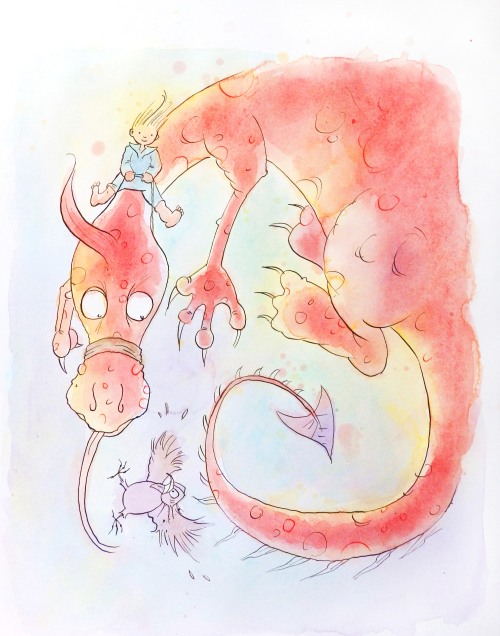
Step 5 – Now I begin adding colours in a more controlled way with the paper dry but mixing the watercolour over the paper by adding clear water to it.
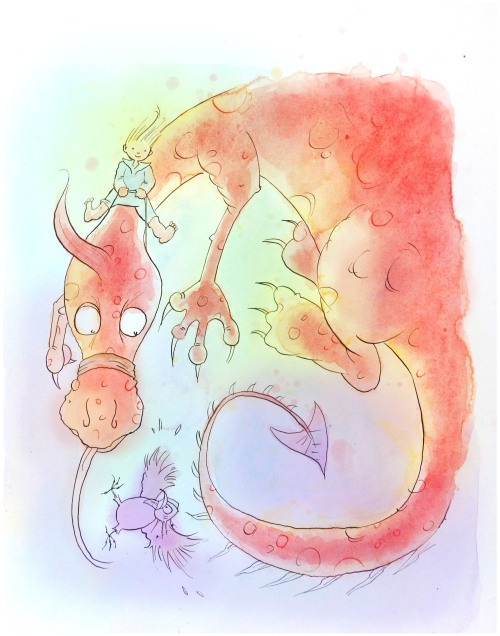
Step 6 – With this particular picture I added the background colours at a later stage.
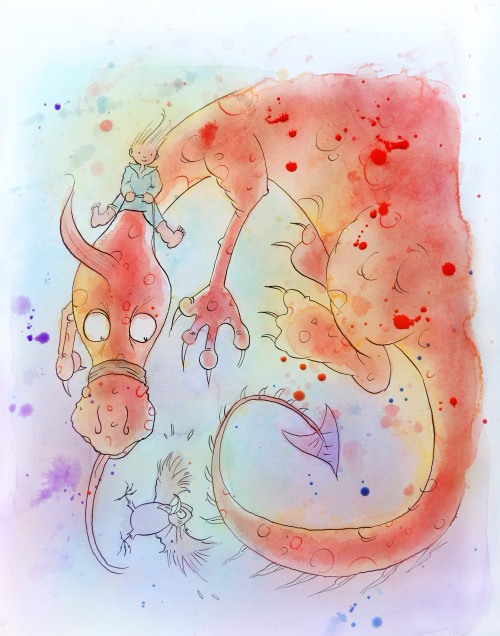
Step 7 – Now I can start adding some texture and pattern by flicking the paintbrush, loaded with paint across the picture – this is great fun!
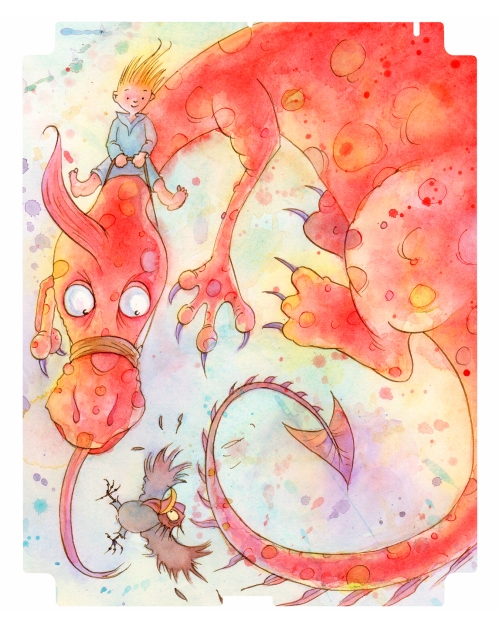
Step 8 – Once dry I then scan the artwork and this instance dropped it into a template for an iPAD skin using Photoshop.

How long have you been illustrating?
Over 20 years
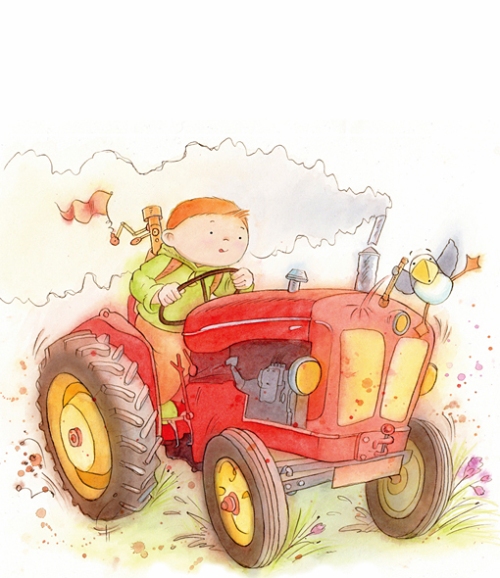
Did you go to college for art? If so, where I attended.
Southwark College off the Old Kent road in London, where I completed a B/Tec diploma. I then went onto to do a BA Hons at Middlesex University in 3D design. I originally worked in television and am self taught as an illustrator.
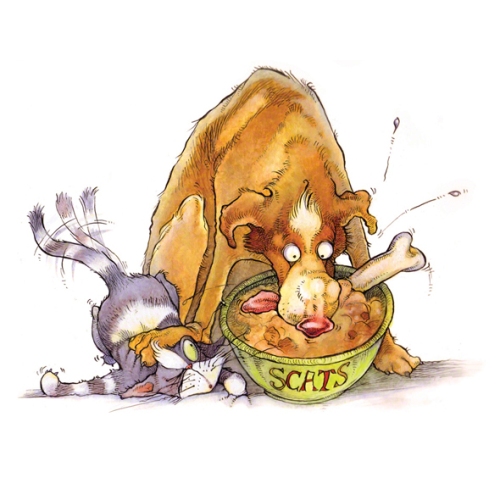
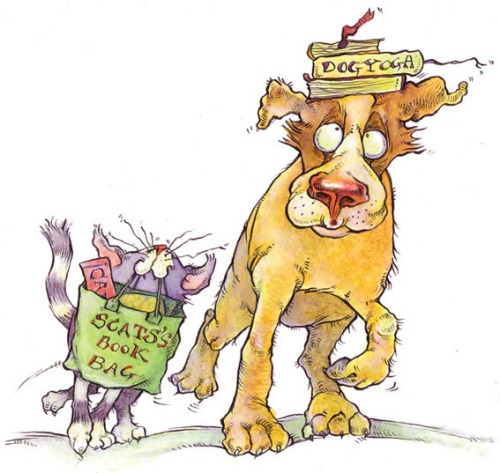 How did you decide to attend that school?
How did you decide to attend that school?
Well the first college had a really good reputation at the time and a very good tutor for drawing, even though we did call him Hitler, because he worked us so hard! My second choice probably wasn’t a good one, as I should have done an illustration course, maybe at Brighton, but I learned a range of skills from doing it.
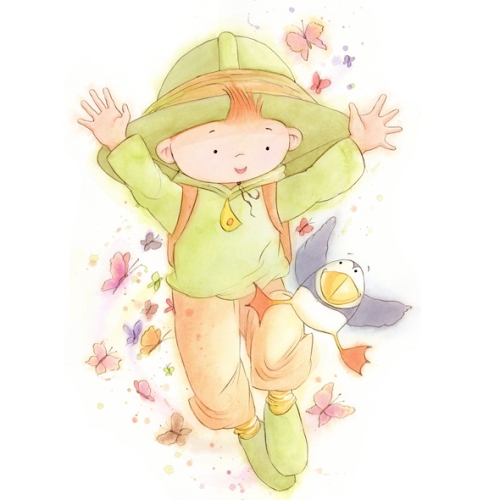
Can you tell us a little bit about the school and the type of degree you received?
Well it was 3-dimensional work, so ceramics, jewellery making, glass blowing, silversmithing, furniture making, etc., we also studied the history of art.
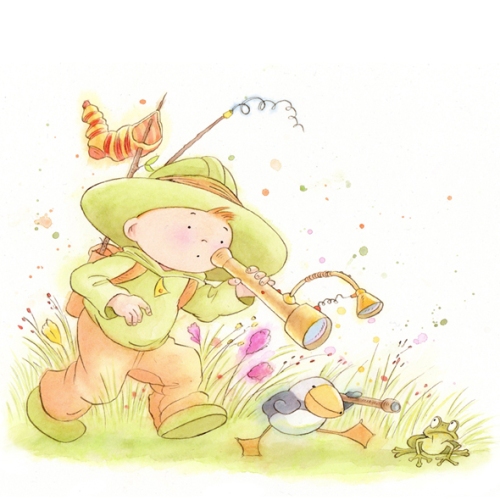
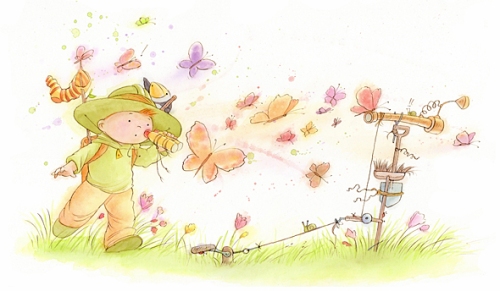 What were you favorite classes?
What were you favorite classes?
History of art and probably ceramics
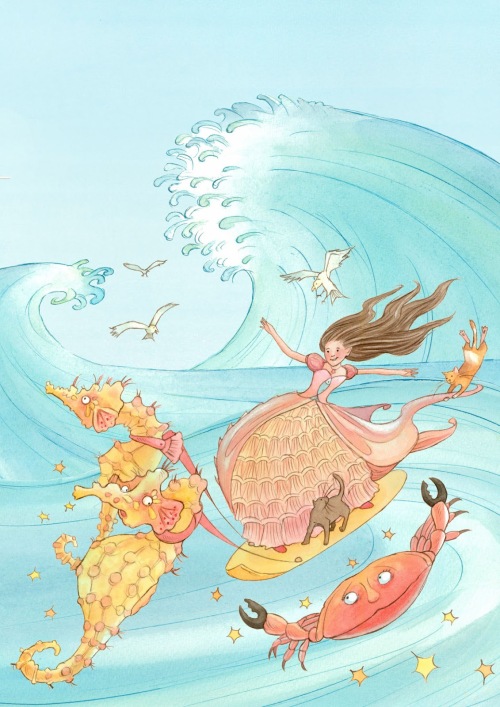
Did the School help you get work?
No. It’s the one bad thing they do not do. You never get to hear about what it’s really like out there in the real world. Universities could do with introducing a few lectures on this subject alone. I am very self-motivated. A year before I was due to graduate I approached the head of design at ITV television. He interviewed me with my portfolio and said to contact him when I graduated. I did and he gave me my first job!
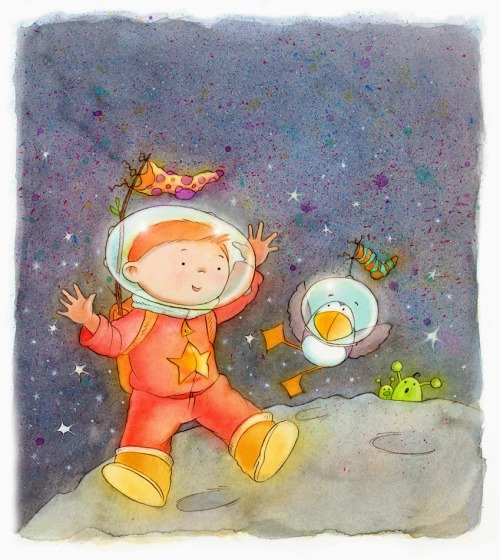
What type of work did you do right after you graduated?
I worked on many different British TV shows for both ITV and the BBC.
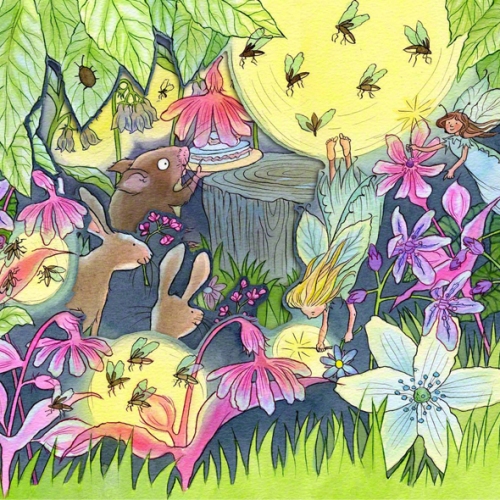
Do you feel that the classes you took in college have influenced your style?
No. I have been influenced by other artists and illustrators. I love the artists Turner and Kandinksy, the illustrators Peter Woodroft, Chris Riddell and my favourite by far is Heath Robinson!
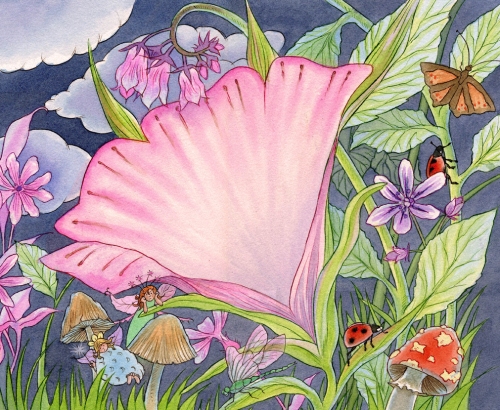
What was the first art related work that you did for money?
I guess for TV. I built a 25th scale model of The Bill set, and for 10 years it was on display in the MOMI, The Museum Of Moving Image in Central London.
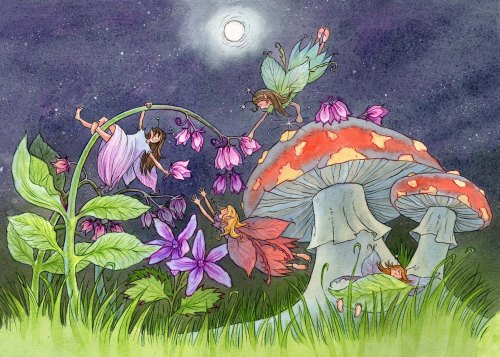
When did you decide you wanted to illustrate a children’s book?
I sort fell into it really. A friend of mine wrote travel books and wrote a children’s play that he wanted illustrated. I was known by that time as being very good at creating leaving cards for people, and he suggested I illustrate his book. The publisher then proceeded to use me for more projects, and it very gradually snowballed.
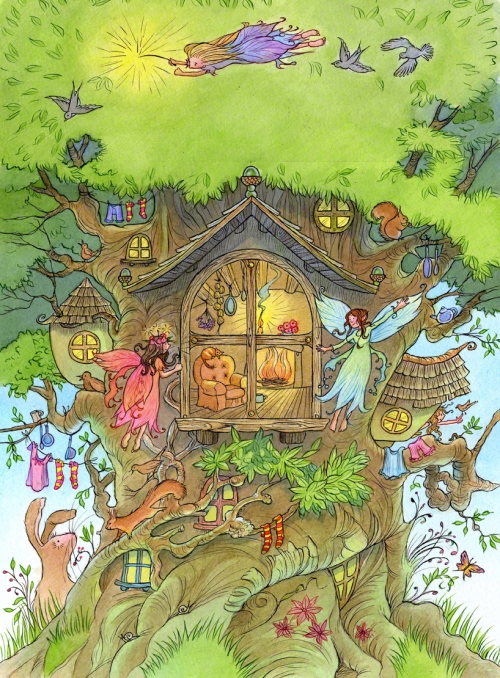
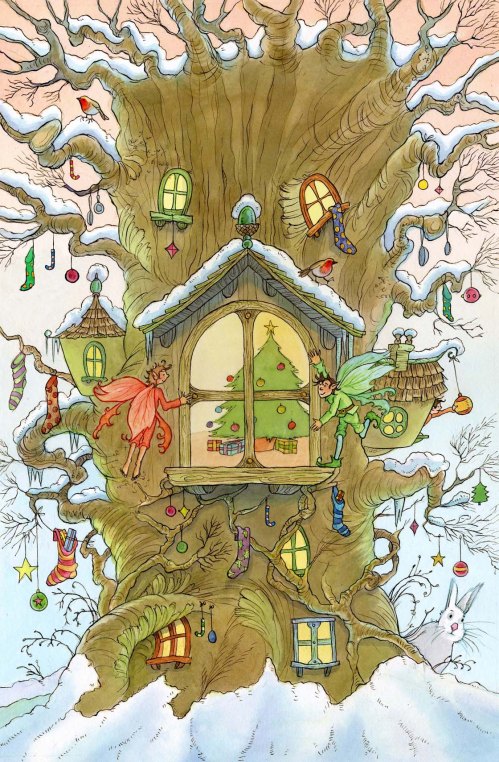
What was the first book you illustrated?
My friend’s play, entitled The Looking-glass Alchemist
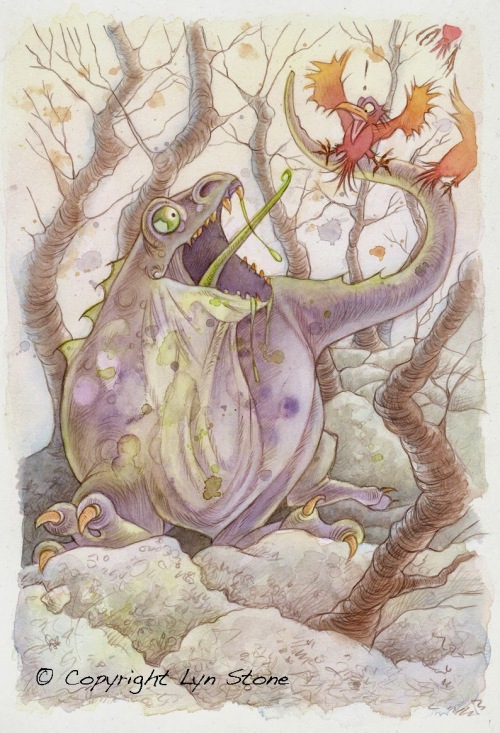
How did that contract come about?
My friend really put my name forward to the publisher. In those days you could get away with that, lol.
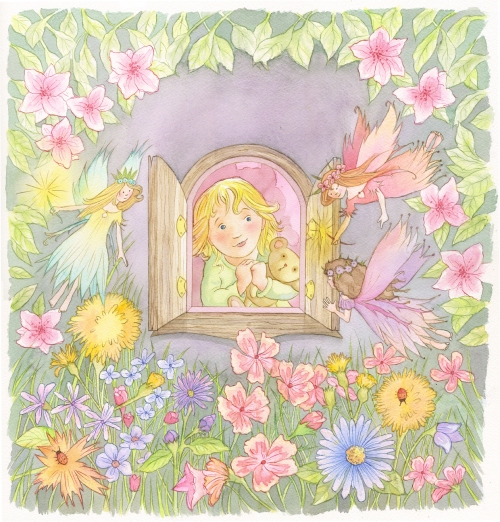
What do you consider is your first big success?
My first commission with Oxford University Press.

How did that opportunity come about?
I sent them samples of my work and they asked me to produce a single illustration. What I didn’t realise at the time was that I was competing with three other illustrators for the commission! I got it – hurrah! I had to do over 150 illustrations – a huge project.
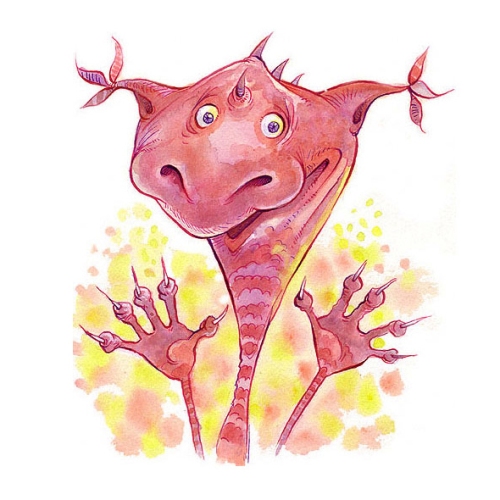
How many picture books have you illustrated?
A true 25-page illustrated picture-book is something I am yet to be commissioned to do – come on publishers, give me that commission! However I have illustrated over 43 books!
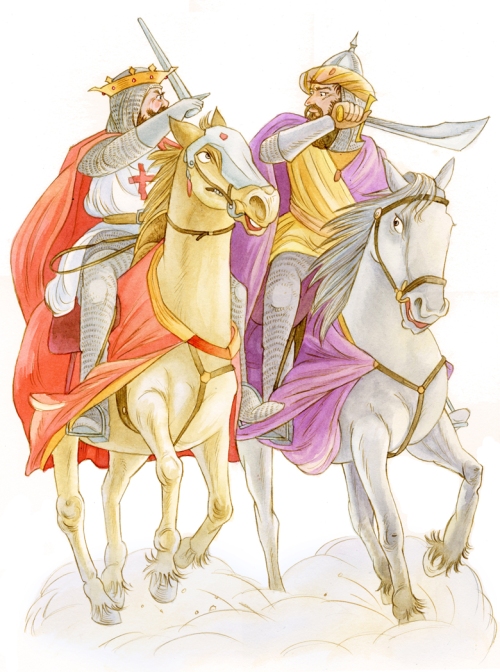
I see you were a model-maker for television. What does a model maker do?
Well a range of interesting things. I used to make mini models of sets, so cameramen could work out where to film, models that were props on set, and models for exhibition purpose.
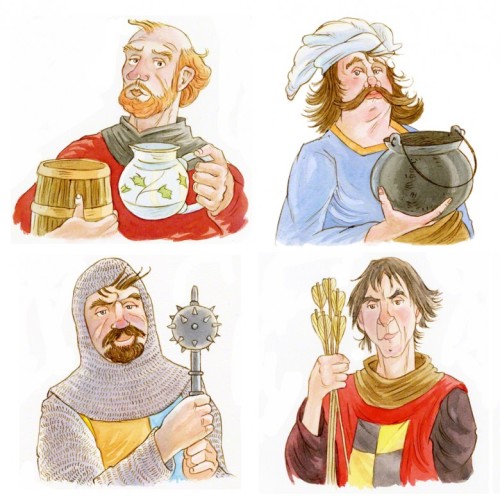
How did you get involved in creating pop-up books?
To some publishers my style seems to lend itself to the pop-up genre. The first one I did was a dummy book for the Bologna book fair for Templar Publishing.
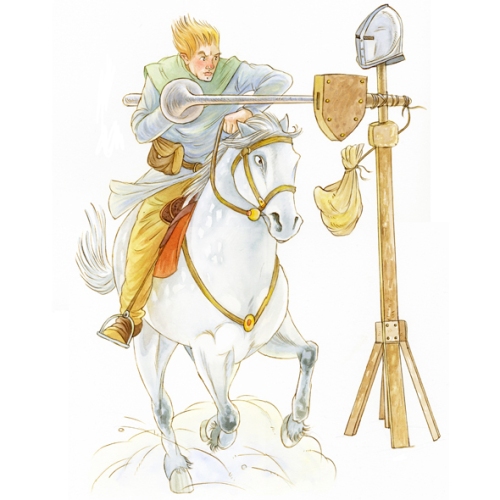
Do you work with the physical creation and working parts of the pop-up books?
A paper engineer will send me a mock up that actually works and the designer on paper will send me templates, so I know the space my artwork must fill.
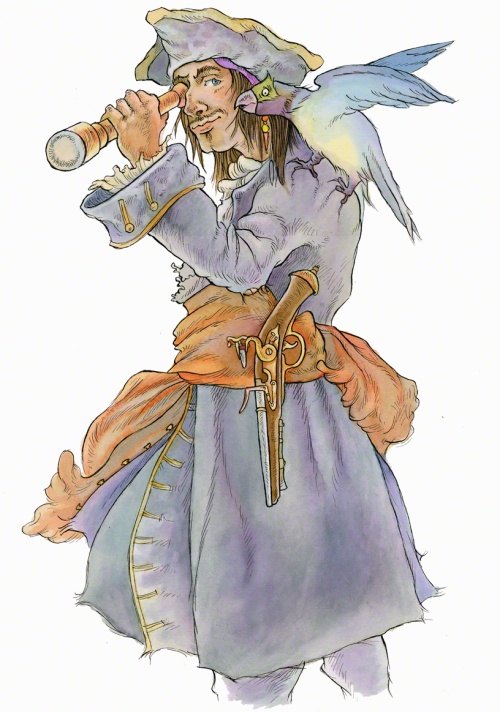
What is the children’s publishing industry like in London?
Well the recent recession hit it a bit and it is picking up again, but you cannot get the same fees that were available ten years ago, but that is an international problem. I still love what I do very much, it is just a shame that the profession has been somehow diminished a little by the industry.
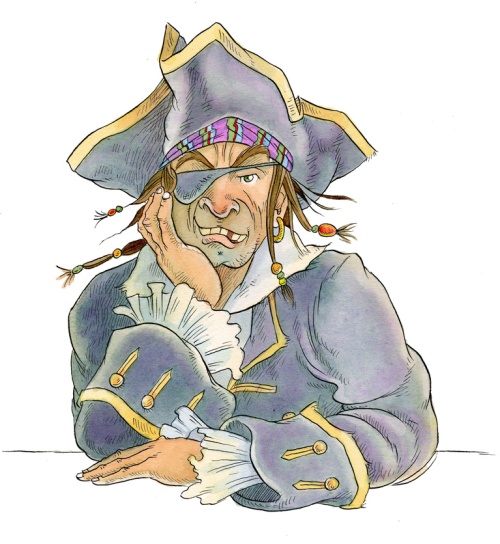
How did you find your agent and how long have you had them?
I have been with Peter now for four years, but tried two others before that. I simply emailed samples of my work and a little of my history and client list (very important if you want to be considered). They receive hundreds of requests weekly, and so I was very lucky.
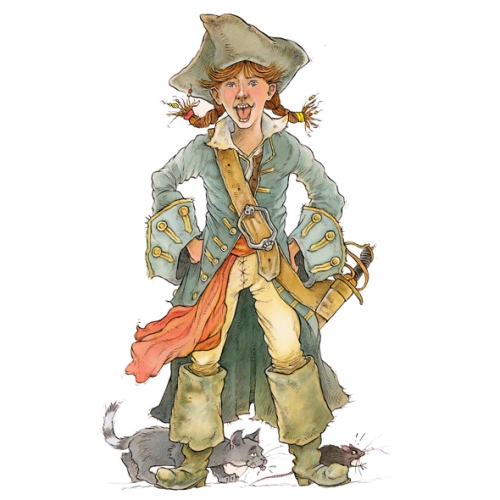
Do you always use watercolor to paint your color illustrations?
No, sometimes inks and I have experimented with mix media too!

What do you use to create your black and white drawings?
An old fashioned dip nib and an acrylic based sepia or black ink. Sometimes however they are created digitally, using illustrator. My greyscale illustrations are created using a propelling pencil with a nice soft led. They’re great because you never need to stop to sharpen them.
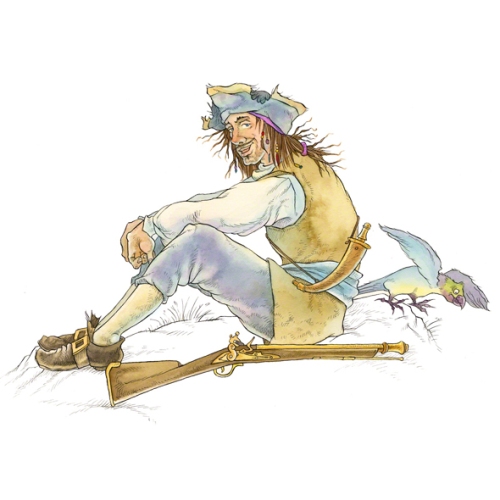
Have you done illustrations for any children’s magazines?
No, but I recently completed working on a two-year project for the Agatha Christie book collection. I illustrated all the villains! Great fun.
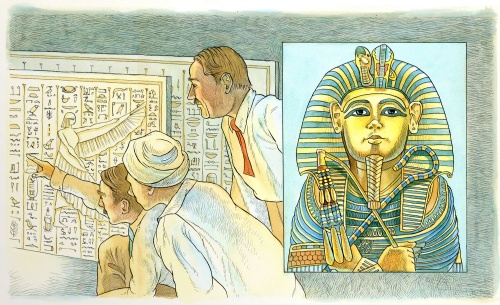
How did you get involved with painting for stage and theatre?
I have never worked in the theatre or on stage as a painter. Only television. However I have produced an illustration for a pantomime, Cinderella for a theatre in Scarborough. It was used on their posters and promotional material.

Have done any artwork for educational publishers?
Yes. Lots and lots.
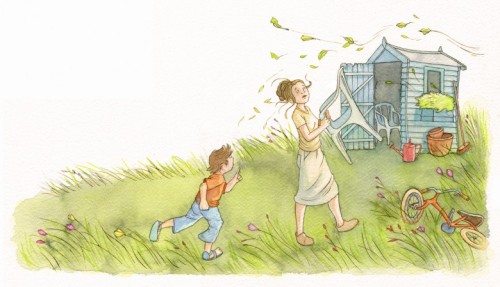
Do illustrators do school visits in the UK?
Yes, and museums and libraries. I have certainly run childrens workshops in both libraries and at a museum – the National Maritime Museum in Greenwich.
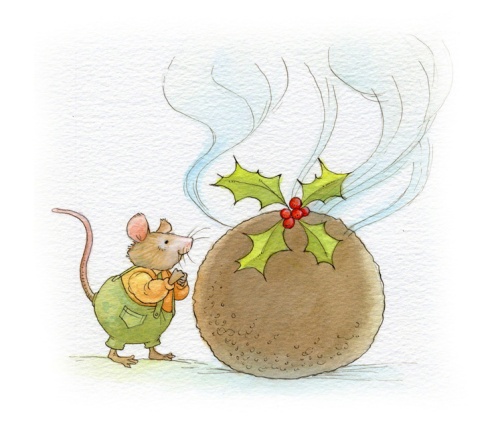
What types of things do you do to find illustration work?
I find the internet is becoming more and more important. I am on several websites, including the AOI, Association of Illustrators. I also blog regularly, tweet and have a Facebook page.
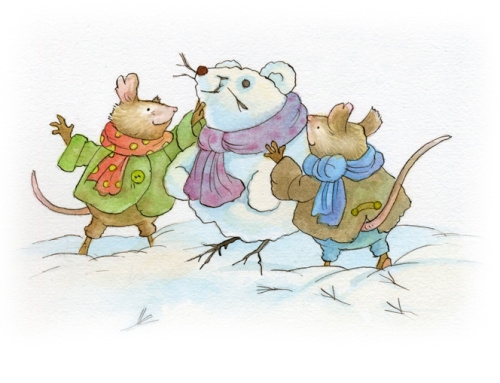
Do you ever exhibit your artwork?
Not yet, no. But what a good idea!
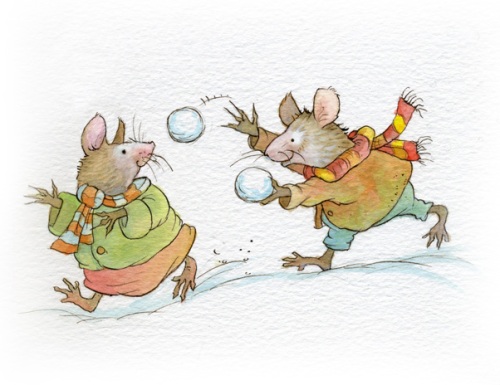
What is the one thing in your studio that you could not live without, other than your paints?
My light box!!!

Do you try to spend a specific amount of time working on your craft?
It varies, if you have a tight deadline then a twelve hour day is quite normal!
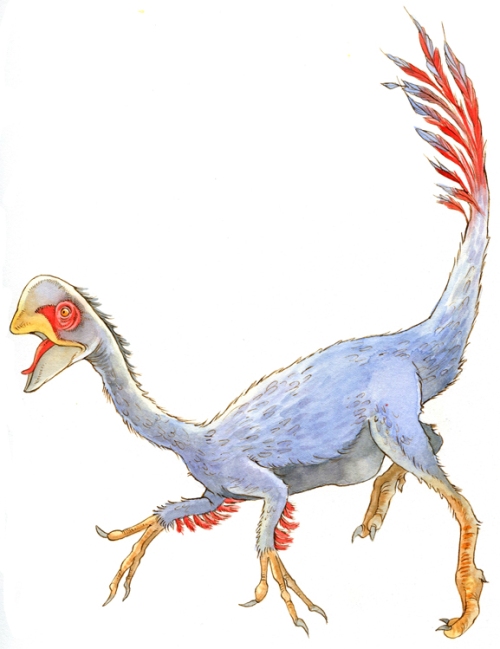
Do you have any desire to write and illustrated your own books?
Yes. I have just written three picture books, which are currently being looked at by Macmillan Books. Hopefully they will buy my project – fingers crossed.
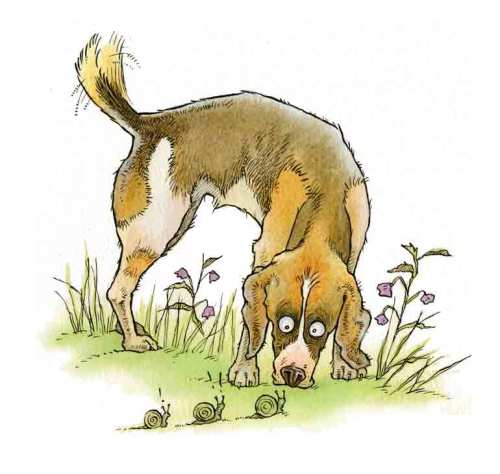
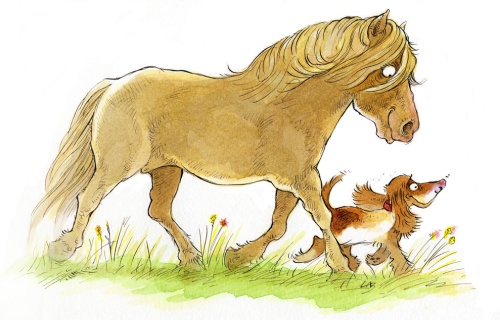
Do you take pictures or do any types of research before you start a project?
Often, yes. Especially for a reference book.

Do you think the Internet has opened doors for you?
Most definitely.
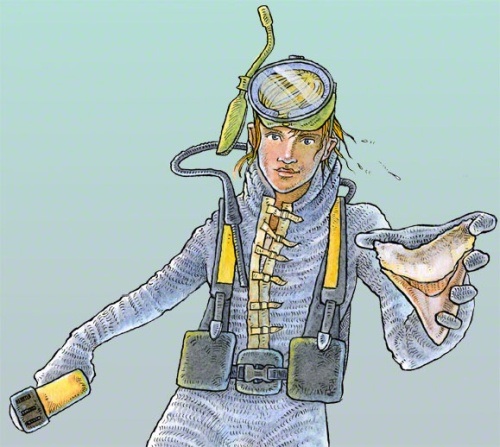
Do you use Photoshop or Corel Painter with your illustrations?
These days publishers very rarely want original artwork, and of course some of my clients are half way round the world. So I tend to scan my illustrations and digitally prepare them to upload to a client, using Photoshop.

Do you own or have you used a Graphic Drawing Tablet in your illustrating?
Yes own and used! I had to do a series of vector illustrations using illustrator. They were all silhouetted characters and animals.
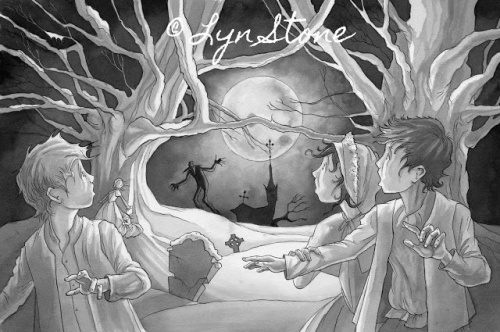
Do you have any career dreams that you want to fulfill?
Yes. To write and illustrate my own books. I have always enjoyed writing too.
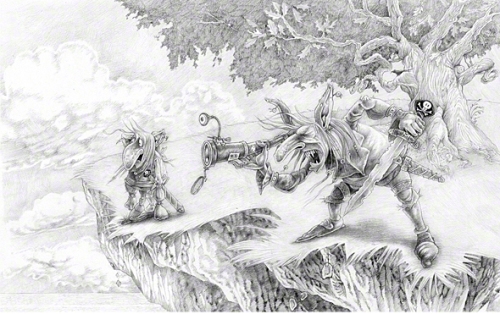
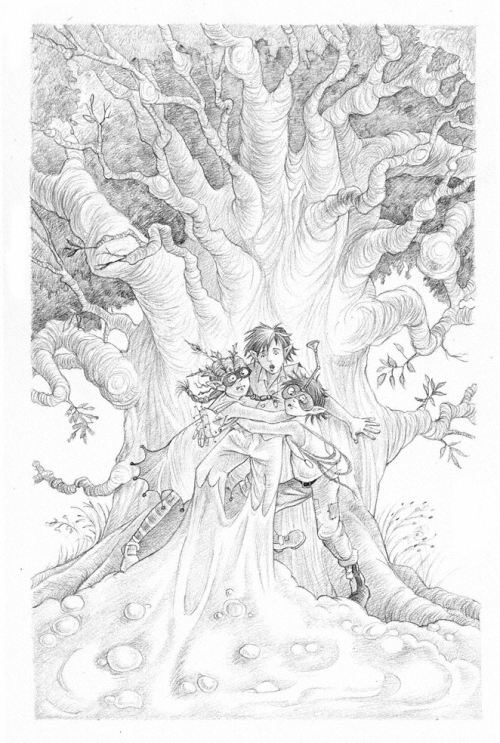
What are you working on now?
Have just completed working on peek-o-boo book. They are quite hard to work on, because you have to think in three dimensions all the time, and there are many layout restrictions. Each page of the book opens up into what I can only describe as a theatre set, and you can peek through to various layers, which together tell a story. Very complex work indeed.
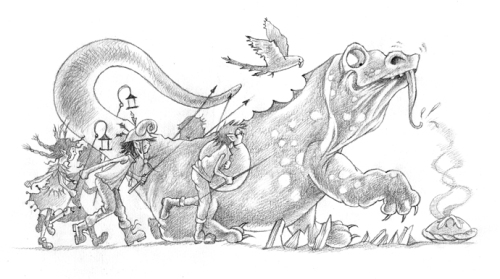
Do you have any material type tips you can share with us? Example: Paint or paper that you love – the best place to buy – a new product that you’ve tried – A how to tip, etc.
I particularly like using Fabriano heat sealed, hand made watercolour paper. It has no knot at all, and takes a bit of knocking about too. Very good quality paper indeed. All artists are different. I prefer to stretch my paper first, the old fashioned way. You can throw as much water and paint at it as you like and it always dry completely flat, which makes scanning less of a headache. My father taught me how to stretch paper as a child.
My favourite art shops are Corneillison & Sons, in Great Russell Street, London, and Chromos in Canterbury. Both hold extremely good stock.
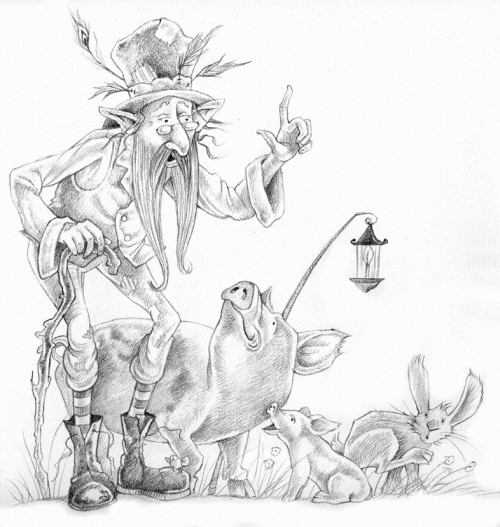
Any words of wisdom on how to become a successful writer or illustrator?
You need a will of iron, determination, patience. Unless you are extremely lucky, it can take years to become truly established. Grow a thick skin too. Publishers can be quite harsh about your work when it gets to editing roughs stage. Join an illustration association, as they can provide you with advice on fees and legal advice. They can often provide standard contracts too that you can give to potential clients, and so well worth joining. Above enjoy what you do!
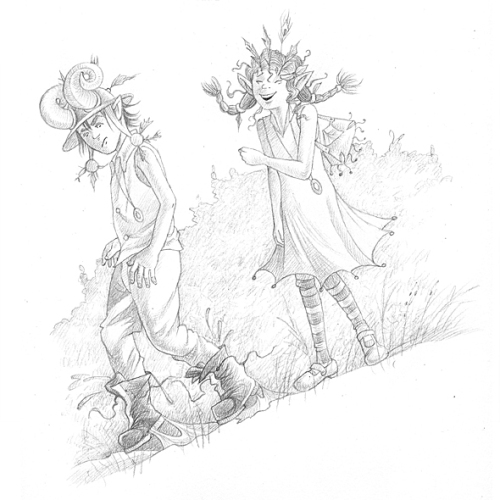
Lyn thank you for sharing your wonderful illustrations, process, journey, and expertise with us. Please keep in touch and let us know of all your future successes. We would love to hear about them.
You can visit Lyn at her website: http://www.lynstone.com or stop by the agency that represents her: The Illustrator Agency
Please take a minute and leave Lyn a comment. It is always appreciated. Thanks!
Talk tomorrow,
Kathy
Filed under:
How to,
illustrating,
Illustrator's Saturday,
inspiration,
Interview,
Process,
Tips Tagged:
Armadillo Childrens books.,
Lyn Stone,
Templar Publishing 


By: Kathy Temean,
on 3/25/2014
Blog:
Writing and Illustrating
(
Login to Add to MyJacketFlap)
JacketFlap tags:
Writing Tips,
reference,
Advice,
Process,
David Diaz,
How to,
Query Tips,
Sylvia Liu,
Links to Query letter Info,
New Voices Award Winner,
Query letter Example,
Add a tag
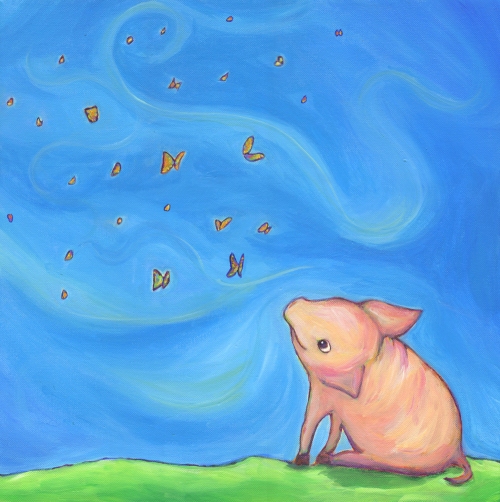
This cute little piggy was sent in by Sylvia Liu. Sylvia was selected the 2013 New Voices Award winner by Lee and Low Books and my debut picture book, A MORNING WITH GONG GONG, is scheduled to be published in Fall 2015. She is part of the 2013 Nevada SCBWI Mentor Program and being mentored in illustration by Caldecott-winner David Diaz.
TIPS:
1. Always address your query to a specific person.
2. Make sure you mention the title of your book in third paragraph.
3. Mention the word count and genre of your book in third paragraph.
Note: Novels should be 80,000 to 100,000 words. Young adult novels can be significantly less: 40,000-60,000 words. Insert word count and genre at the end of your first “hook” paragraph.
If your novel is 200,000 words – Cut before you query. No one wants an overweight manuscript. AgentQuery reports unless your manuscript is a historical family saga or an epic science fiction battle, agents hit DELETE on proposed first-time novel over 110,000-120,000 words.
4. Share the reason why you are querying this particular agent. Let the agent know that you have researched them and have a reason for choosing them for representation.
5. Have someone you know check for typos and grammar mistakes. It is very easy when e-mailing a query letter to click the send button before throughly checking your text. Writers seem to be in the mode to triple check everything when they snail mail their queries, but since we send so many personal e-mails without closely checking every word, that “Send” button can be easily clicked. The mistake snail mailing query writers make is forgetting to include their contact information – something you don’t need to include with an e-mail. I know that sounds crazy, but I have seen it when writers have sent me submissions for editors and agents.
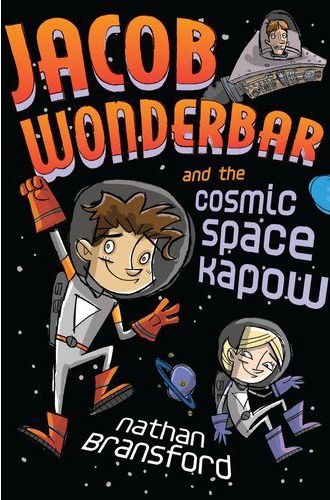 Need to see an ACTUAL query letter before you’ll know how to write one? Here is the query letter Author (at the time agent) Nathan Bransford:
Need to see an ACTUAL query letter before you’ll know how to write one? Here is the query letter Author (at the time agent) Nathan Bransford:
Dear Ms. Drayton,
As a young literary agent with Curtis Brown Ltd. I have long admired Inkwell, as well as your strong track record. To paraphrase Douglas Adams, if you searched for a book that was almost, but not quite, entirely unlike THE BOOK THIEF (which I absolutely loved), you might just have JACOB WONDERBAR AND THE COSMIC SPACE KAPOW, a middle-grade-and-up science fiction novel that I just completed. Still fun! But no one dies – Mr. Death would be lonely.
Jacob Wonderbar has been the bane of every substitute teacher at Magellan Middle School ever since his dad moved away from home. He never would have survived without his best friend Dexter, even if he is a little timid, and his cute-but-tough friend Sarah Daisy, who is chronically overscheduled. But when the trio meets a mysterious man in silver one night they trade a corn dog for his sassy spaceship and blast off into the great unknown. That is, until they break the universe in a giant space kapow and a nefarious space buccaneer named Mick Cracken maroons Jacob and Dexter on a tiny planet that smells like burp breath. The friends have to work together to make it back to their little street where the houses look the same, even as Earth seems farther and farther away.
JACOB WONDERBAR AND THE COSMIC SPACE KAPOW is 50,000 words and stands alone, but I have ideas for a series, including titles such as JACOB WONDERBAR FOR PRESIDENT OF THE UNIVERSE and JACOB WONDERBAR AND THE VACATIONING ALIENS FROM ANOTHER PLANET. I’m the author of an eponymous agenting and writing blog.
I’d be thrilled if you would consider WONDERBAR for representation, and a few other agents are considering simultaneously. Thanks very much, and hope to talk to you soon.
Nathan Bransford
Here are a few other places to look:
Nathan Bransford dissects a really good query letter and extoll its virtues.
Click Here to Visit Galleycat. They have 23 Agent Query Letters That Actually Worked.
Nonfiction writers don’t need to have a completed manuscript. They only need a proposal before seeking representation from an agent. Here’s are books and places to help with writing a proposal:
Talk tomorrow,
Kathy
Filed under:
Advice,
How to,
Process,
reference,
Writing Tips Tagged:
David Diaz,
Links to Query letter Info,
New Voices Award Winner,
Query letter Example,
Query Tips,
Sylvia Liu 


By: Kathy Temean,
on 3/24/2014
Blog:
Writing and Illustrating
(
Login to Add to MyJacketFlap)
JacketFlap tags:
Agent,
Writing Tips,
reference,
Advice,
Process,
Noah Lukeman,
How to write a query letter,
How to,
Breaking down the Query Letter,
One page Query letter,
Add a tag
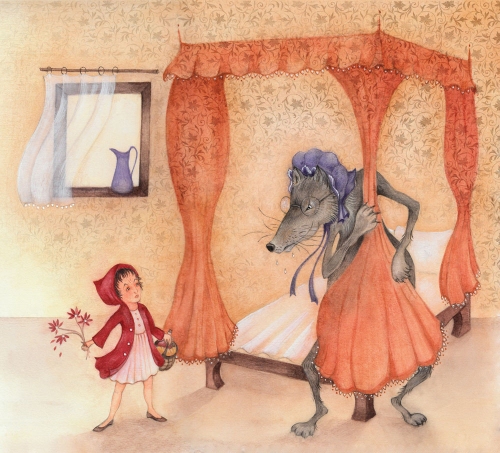
You can see from the above illustration by Evi Gstottner that she loves fairytales and folktales. She graduated in 1992 from Byam Shaw School of Art in London and in 2009 she completed her MA in Children’s Book Illustration at the Anglia Ruskin University (Cambridge School of Art). Evi was featured on Illustrator Saturday. Here is the link: http://www.kathytemean.wordpress.com/2013/03/23/illustrator-saturday-evi-gstottner/
The goal of query letter is to elicit an invitation from an agent (or editor) to send in sample chapters or the whole manuscript.
A query letter is a ONE PAGE letter with three concise paragraphs: the hook, the mini-synopsis, and your writer’s biography.
Don’t stray, if you want to be taken seriously as a professional writer. Keep it simple. Stick to three paragraphs.
Paragraph One is called The Hook: A hook is a concise, one-sentence tagline for your book. It’s meant to hook your reader’s interest, and reel them in.
The first paragraph is your chance (perhaps your only chance) to grab the agent, since many agents will be immediately biased—for good or for bad—within a sentence or two.
If a writer queries via a referral, he will always begin with, “I am writing to you because your client, John Smith, recommended that I do so.” Thus an agent, whether he likes it or not, must take the first sentence seriously, if for no other reason than he risks offending an existing client check or editor. Please do not say this unless it is true. Agents will check and you don’t want to be embarrassed or have someone think you are not trustworthy.
If you haven’t been referred, you could still grab the agents attention with something personal., such as: ”I am writing to you because you represented TITLE by AUTHOR, and I feel my book is similar.”
What will this show?
1. That this is not a random query letter.
2. That you’re approaching him/her for a specific reason
3. That you’ve put a great deal of time and energy into researching the market
4. That you know who the agent represents, and the types of books they have sold.
5. It will put a positive association into the agents mind, as it will make him or her think of a book they sold.
6. It offers a comparison, allowing the agent to immediately grasp the type of book you’re writing and thus help they agent decide if they want to represent another like it.
7. It shows that you know the market, that you have an objective grasp of what your own book is about and where it fits within that market.
8. It indicates that you’ve put care into your writing.
Referencing one of his/her titles will help accomplish this. But don’t bluff. Noah says, ”If you don’t truly do the research, it will show. I’ve received many letters which referenced a book I sold, but when I read the rest of the query, I realized that their book was not at all similar; it was just a gimmick to get me to pay attention. When an agent realizes this, he will just be annoyed. So when referencing a book, make sure it is truly appropriate. But if you’ve done the research and query a truly appropriate agent and reference a truly appropriate title, then you are already off to a shining head start.”
Agent Query suggests using the when formula: “When such and such event happens, your main character—a descriptive adjective, age, professional occupation—must confront further conflict and triumph in his or her own special way. Sure, it’s a formula, but it’s a formula that works.”
Example: Bridges of Madison County
When Robert Kincaid drives through the heat and dust of an Iowa summer and turns into Francesca Johnson’s farm lane looking for directions, the world-class photographer and the Iowa farm wife are joined in an experience that will haunt them forever.
Note: Many writers use the “when” formula, so use it as a starting point. Write your basic hook and then spice it up with the “When. Noah says to keep your opening paragraph to one sentence, so if you add a when to the personal approach, make sure it is short.
Example: Non-”formulatic” fiction hook:
The Da Vinci Code A murder in the silent after-hour halls of the Louvre museum reveals a sinister plot to uncover a secret that has been protected by a clandestine society since the days of Christ.
Paragraph Two—Mini-synopsis: This is where boil down your entire novel into one paragraph and expand your hook. Put in the hard work of practicing and revising, until you get that paragraph to sing the same tune as your whole book. Read the back flap of books you like to get a feel for how to create a juicy paragraph.
Paragraph Three—Writer’s bio: Keep it short and related to writing. If your book revolves around a hospital and you are a nurse, then say that. If you have a published book, been published in some magazines, etc,, or won a writing contest or award, then let the agent know. if you’ve never been published, never won any awards, hold no writing degrees, and have no credentials to write your book, then don’t say it. This just gives you more space for Paragraph Two.
The Closing: Thank the agent for their time and consideration. Let the agent know you have the full manuscript available upon request. Note: Never query an agent unless you have written, revised, and finished your full manuscript.
Tomorrow: Query Tips – Examples and Links.
Talk tomorrow,
Kathy
Filed under:
Advice,
Agent,
How to,
Process,
reference,
Writing Tips Tagged:
Breaking down the Query Letter,
How to write a query letter,
Noah Lukeman,
One page Query letter 

.png.jpg?picon=4257)
By: Diana Hurwitz,
on 3/21/2014
Blog:
Game On! Creating Character Conflict
(
Login to Add to MyJacketFlap)
JacketFlap tags:
conflict,
editing,
writing,
character,
behavior,
action,
how to,
distance,
ficiton,
physical,
body language,
boundaries,
personal space,
reaction,
touching,
Add a tag
Cuddling, kissing, and hugging are often signs of affection. They could be signs of aggression if the character receiving the affection doesn't want it.
There are situations in which a character must control involuntary responses, especially if Dick is a spy, a cop, or pretending to be someone he isn’t. If faced with an angry mugger or screaming toddler, Dick's initial primordial response might be recoil. His body might tense to strike. If it is a mugger, he lets the punch fly, unless the mugger is holding a gun pointed at his head. If it is a toddler, Dick overrides the urge to strike and deals with it another way, unless he has poor self-control or the child is demon-possessed.
Every character has a different idea of how close is close enough when speaking to other people. We call it personal space. It's uncomfortable when someone stands too close. It is crossing a psychological boundary.
Some characters are touchy-feely types. An extrovert is more likely to be a hands-on kind of guy. An introvert hates being touched by people he doesn't know very well. A character who has been abused may not want anyone to touch him, no matter the reason, loving or otherwise.
Some families and cultures are big on physical displays of affection, others aren't. A character might hug every one he has ever met upon seeing them again. Others prefer a handshake or a bow. The reasons can be personality, culture, or life experience.
Touch denotes a degree of intimacy. Someone touching Dick's shoulder could mean multiple things: desire, anger, or compassion. Little kids touch more than adults. A toddler is not self-conscious about where his hands land or where his head rests. The elderly can crave touch as much as toddlers. It may be decades since someone has hugged them or held their hand.
Jane might not mind being touched by a lover or best friend. She might object to being handled by a stranger at a party. Friends and family touch Jane to greet her, tease her, get her attention, help her, or hinder her. How comfortable she is with them makes a difference in how well she tolerates it.
Jane may normally love being touched by her husband until she is angry with him. How your character feels affects how she processes the touch and the person touching her.
There are times when someone we don't know very well needs to touch us: massage therapists, hairdressers, doctors, nurses, medical personnel, rescue personnel, etc. A teacher may have to touch a child to direct him. A guard may have to touch Jane to direct her. It may make the character very uncomfortable. Children involved in sports are used to being tackled, patted, or punched by teammates. Others aren't.
Characters that are deceptive, don't like themselves, or are ashamed of something may avoid touch. They are uncomfortable when someone approaches them, pats them on the back, or moves in for a hug. Pedophiles touch inappropriately.
When a person touches Jane and it feels off, it sends a frisson of alarm through her system. Depending on the circumstances, Jane may subconsciously recoil, but consciously blow it off and make excuses for it. However, her subconscious remains on high alert until the danger has passed.
When describing touch in your fiction, make sure it is appropriate for the circumstances.
Make sure you tell the reader how the character feels about being touched. Is it a good thing or a bad thing?
What kind of caress, hug, or handshake was it?
Is Jane’s instinctive response to pull away when she knows she has to endure the hug?
These small conflicts illustrate character, reveal relationships, and make characters very uncomfortable at scene level.
Touch ignites an involuntary response, followed by a voluntary response, followed by a recovery. Illustrate the beats during critical encounters. The how and why are important. Was the touch appropriate or inappropriate? Tolerated or defended? Welcome or unwelcome?
Next we will discuss facial expressions.

By: Kathy Temean,
on 3/19/2014
Blog:
Writing and Illustrating
(
Login to Add to MyJacketFlap)
JacketFlap tags:
How to,
demystify,
Australian Illustrator,
Celcilia Clark,
Synopsis Checklist,
Synopsis evaluation,
Writing Tips,
list,
reference,
Process,
Add a tag

This illustration my Cecilia Clark gives us a glimpse of what awaits us after this long cold winter. Cecilia is a budding writer and illustrator from Australia. Her writing and illustrating has been published in anthologies. She is a member of SCBWI Australia and New Zealand(Society of Children’s Book Writers and Illustrators) the Fellowship of Australian Writers (FWA) and Romance Writer’s Australia(RWA). http://ceciliaaclark.blogspot.com.au
Synopsis Checklist:
1. Is your synopsis between one and three pages? Double spaced if more than one page?
2. Does the opening paragraph have a hook to keep the editor or agent reading?
3. Did you use capital letters the first time you introduced a character?
4. Did you show your characters goal, motivation, conflict, and growth?
Your synopsis should give a clear idea as to what your book is about, what characters we will care about (or dislike), what is at stake for your heroes, what they stand to lose, and how it all turns out.
5. Have you hit on the major scenes, the major plot points of your book, and include the ending?
6. How you gotten to the who, what, where, when and why in your synopsis?
7. Do you keep the interest level up throughout the synopsis?
8. Is there good flow between paragraphs.
9. Have you avoided all grammar, spelling, and punctuation mistakes?
10. Do you think you captured the flavor of your manuscript?
See yesterday’s post for synopsis details.
Talk tomorrow,
Kathy
Filed under:
demystify,
How to,
list,
Process,
reference,
Writing Tips Tagged:
Australian Illustrator,
Celcilia Clark,
Synopsis Checklist,
Synopsis evaluation 

View Next 25 Posts







 Jersey Farm Scribe here, on….
Jersey Farm Scribe here, on….
 Leslie Zampetti has had stories published in online children’s magazines and is now querying agents for her middle grade fantasy novel. A childhood spent in Florida has this transplanted New Yorker frequently dreaming of sunshine – but she enjoys the whirl of the city and its riches, not least of which is the New York Public Library.
Leslie Zampetti has had stories published in online children’s magazines and is now querying agents for her middle grade fantasy novel. A childhood spent in Florida has this transplanted New Yorker frequently dreaming of sunshine – but she enjoys the whirl of the city and its riches, not least of which is the New York Public Library.
 Gideon Kendall was born in Austin, Texas and spent his childhood on a commune deep in the backwoods of West Virginia. He attended high school in Philadelphia, PA and moved to New York City to attend art school. Since receiving his BFA from The Cooper Union in New York City (1989) he has been working as an illustrator, animation, designer, and musician in Brooklyn, NY.
Gideon Kendall was born in Austin, Texas and spent his childhood on a commune deep in the backwoods of West Virginia. He attended high school in Philadelphia, PA and moved to New York City to attend art school. Since receiving his BFA from The Cooper Union in New York City (1989) he has been working as an illustrator, animation, designer, and musician in Brooklyn, NY.


































 Did you know it was going to be a series when you illustrated the first book?
Did you know it was going to be a series when you illustrated the first book? 





























 What’s most impressive about Seinfeld’s career isn’t the awards, the earnings, or the special moments — it’s the remarkable consistency of it all. Show after show, year after year, he performs, creates, and entertains at an incredibly high standard. Jerry Seinfeld produces with a level of consistency that most of us wish we could bring to our daily work.
What’s most impressive about Seinfeld’s career isn’t the awards, the earnings, or the special moments — it’s the remarkable consistency of it all. Show after show, year after year, he performs, creates, and entertains at an incredibly high standard. Jerry Seinfeld produces with a level of consistency that most of us wish we could bring to our daily work. Lyn Stone has worked in a variety of jobs, including a Curator at the Tower of London. Being rather small she was the only member of staff who could climb into the display cabinets to clean Henry VIII’s Codpiece, whilst Japanese tourists happily took photographs! She can also boast accidentally shocking an Amerian tourist who mistook two flintlock dueling pistols for gun with real amo! She has also worked as a freelance model-maker for television, working on a variety of shows, for the BBC and ITV. As a model-maker she found herself working with puppets, actors as well TV crew. On one memorable occasion Lyn made a model so big, it had to be built in her garage. Much to the amusement of all her neighbours when a large lorry, bearing the slogan ‘British Broadcasting Corporation’ turned up to collect it and struggled up a very narrow lane!
Lyn Stone has worked in a variety of jobs, including a Curator at the Tower of London. Being rather small she was the only member of staff who could climb into the display cabinets to clean Henry VIII’s Codpiece, whilst Japanese tourists happily took photographs! She can also boast accidentally shocking an Amerian tourist who mistook two flintlock dueling pistols for gun with real amo! She has also worked as a freelance model-maker for television, working on a variety of shows, for the BBC and ITV. As a model-maker she found herself working with puppets, actors as well TV crew. On one memorable occasion Lyn made a model so big, it had to be built in her garage. Much to the amusement of all her neighbours when a large lorry, bearing the slogan ‘British Broadcasting Corporation’ turned up to collect it and struggled up a very narrow lane! 










 How did you decide to attend that school?
How did you decide to attend that school?

 What were you favorite classes?
What were you favorite classes?






































 Need to see an ACTUAL query letter before you’ll know how to write one? Here is the query letter Author (at the time agent) Nathan Bransford:
Need to see an ACTUAL query letter before you’ll know how to write one? Here is the query letter Author (at the time agent) Nathan Bransford:


Thanks for sharing this. I’ve got my query letter ready to go and my agent excel spreadsheet started, so this was helpful to read over as I continue mentally preparing myself for sending out those submissions.
Thank you, Erika, for your reminders.
Thanks to both sjoycarlson and Barbara Gold. I appreciate your feedback and am glad you find it useful! Thanks for your comments!
Reblogged this on thejerseyfarmscribe and commented:
Hey guys! Check out today’s guest post on Kathy Temean’s Writing and Illustration blog.
So you’ve got the polished manuscript and you’re ready to submit. But to who? It’s worth it to research your agents beforehand! Here’s how.